

Clinical psychology
- Anxiety disorders
- Feeding and eating disorders
- Mood disorders
- Neuro-developmental disorders
- Personality disorders
- Affirmations
- Cover Letters
- Relationships
- Resignation & Leave letters
Psychotherapy
Personality.
Table of Contents
Problem Solving Activities for Adults Speech Therapy
As a BetterHelp affiliate, we may receive compensation from BetterHelp if you purchase products or services through the links provided.
The Optimistminds editorial team is made up of psychologists, psychiatrists and mental health professionals. Each article is written by a team member with exposure to and experience in the subject matter. The article then gets reviewed by a more senior editorial member. This is someone with extensive knowledge of the subject matter and highly cited published material.
This blog will highlight the problem solving questions and exercises that are most commonly used in Adult Speech Therapy. It will also explore the rationale and process of Speech Therapy, what problem solving entails and how it fits into the practise of speech therapy.
The various possible problem solving approaches that can be used within adult speech therapy would be discussed in detail, along with a brief into speech therapy and it’s need for adults. The blog will also list other approaches that can be used within the domain of speech therapy apart from problem solving.
What Is Speech Therapy?
Human wings are social animals that are able to function within their environment through effective communication. Communication, whether the form of speech or written word enables individuals to express and understand each other, it helps them in forming and sustaining relationships with other people.
Understanding what people are saying and responding to them through effective communication channels is an essential part of being a human, it almost comes as second nature to individuals. Although such is not the case for individuals battling speech and communication disorders. For such people, speech therapy may prove to be an essential tool.
Speech therapy is a psychological intervention that seeks to improve an individual’s ability to understand and produce language. It can help in better comprehension and expression of both verbal and non-verbal language. Speech therapy can also be called speech language therapy, and it helps build communication skills in people. This kind of therapy provides successful support and treatment to individuals with speech problems and communication disorders.
Do Adults Need Speech Therapy?
It is a very common misconception that speech therapy can only serve as useful for children with speech and communication disorders. While speech therapy can help direct children’s language development onto the right path, it’s applications do not end there. Speech therapy can be extremely useful even in the case of adults with long-drawn or newly acquired speech problems.
Adults may seek out speech therapists for a variety of reasons, ranging from regaining communications skills and confidence after trauma or injury or to simply improve on public speaking skills.
Some of the most common reasons for adults to seek out speech therapy can be:
- Stuttering: stuttering is a speech issue wherein a person has a hard time pronouncing certain sounds. It can cause people to either repeat their words or stretch them out. This condition may become exaggerated due to stress and can also be influenced by the person’s feelings.
- Swallowing Issues: Individuals with diseases such as cancer of the jaw, lips, mouth or tongue, and people with neurological issues can develop issues with speech production and clear expression of verbal content. When there are physical problems such as these, a speech therapist may help clients in regaining lost speech functions or to work around them and find alternative routes.
- Trauma and Speech Reception: Speech therapy is not limited to speech production, it can also aid in better comprehension and speech reception. Trauma or accidents are likely to interfere with how people process and understand spoken content; they may face difficulties in focusing attention, understanding what others are saying or retaining information they have received. Speech therapy can also help with developing these skills and improving speech reception.
- Cognitive Disorders or Aphasia: Aphasia is a common communicative disorder which interferes with a person’s ability to clearly speak or understand others. It is often acquired as a result of illness or injury. An individual could also require speech therapy if they have a cognitive-communication disorder, which means that the parts of their brain responsible for speech production are facing problems.
What Happens in Adult Speech Therapy?
A Speech and Language Pathologist is likely to use various techniques as part of adult speech therapy. These can involve:
- Breathing exercises: A speech therapist can use breathing exercises to help people with resonance issues.
- Mouth exercises: Mouth exercises in speech therapy can be a suitable way to strengthen the oral muscle which help control and improve communication.
- Social communication: Speech pathologists could also make use of problem-solving, memory activities, and conversation exercises to improve communication.
- Swallowing exercises: Organic illnesses, like Parkinson’s disease, oral cancer, or a stroke, may cause swallowing difficulties which can also affect clear speech. A speech therapist can use swallowing exercises to help a person resolve and better deal with these issues.
What is Problem Solving In Speech Therapy?
Before understanding how problem solving fits into speech therapy, it is important to review what problem solving means. The term problem solving essentially highlights the mental processes that people use to identify, understand, analyse and overcome problems. It is a multi-step, goal-directed behaviour aimed at overcoming a mental or physical obstacle.
The problem solving process starts with defining a problem. This step usually involves the diagnosis of a situation to collect facts and information for later processing. While a person is attempting to define a problem, they take in information from various sources and try to establish a cause-and-effect relationship between various factors involved in the situation. After a problem situation is successfully conceptualised, people try to look for alternatives solutions that may bring about a resolution. As various solutions are found and evaluated for usefulness, the final stage of problem solving is reached, which is implementation of the shortlisted solution. After scouring through dozens of possible solutions to a particular problem, an individual narrows down on the most feasible option and seeks to implement it as a final solution to the situation.
Within the domain of speech therapy, problem solving exercises, or activities that involve the use of memory systems, organisation and decision making behaviours are most commonly used to treat cognitive communication disorders. Such disorders can affect the way in which people produce or comprehend speech, and they can be a result of either injury or illness.
Adopting a problem solving approach with respect to communication disorders can help adults in adapting to undesirable situations that arise throughout their days. It can even help them gain a better understanding of their speech problems and come to terms with it. Once people are able to comprehend their issues, they will be better equipped to deal with the problems and take steps to improve their situation as suggested by their speech therapists. Problem solving exercises within speech therapy also help in building a person’s confidence and their capabilities for social interaction; which in turn would have benefits for their personal and professional relationships.
Problem Solving Activities In Adult Speech Therapy
Some of the commonly practised problem solving activities within adult speech therapy are:
- Tongue Exercises: The first step in re-training oneself to practise correct speech patterns should be to gain better control over the tongue. Moving and exercising is an essential part of speech therapy. Tongue training exercises can help the mouth to move easily in coordinated patterns which can greatly improve the quality of speech production.
- Expression Game: Standing in front of a mirror and practising a list of expressions is also a great cognitive exercise within speech therapy. Reading a list of expressions and then attempting to recreate them in the mirror provides the rain with essential feedback. This stimulates the brain and allows individuals to observe their progression real time. Not only this, it can also help in strengthening the muscles in a person’s face and mouth.
- Reading and Sentence Production: Patients with organic speech disturbances like apraxia can benefit from reading activities. Reading small passages and repeating them out loud can help such patients to strengthen their lip and tongue muscles. A speech therapist may start off by asking them to practice one or two sentences initially for short periods of time, and gradually increase theory timings and workload.
- Word Games: Word games either through the use of computers or with people around oneself can prove to be a great way to exercise the brain’s speech and language centers. These games can either rely on quick production or quick comprehension and repetition of speech. They force individuals to pay and sustain attention, and make use of their speech centers.
- Computer Games: Computer games like solitaire or alchemy are sometimes also used with speech therapy clients. Although these games do not rely on active production of speech, they can still help exercise the cognitive-linguistic pathways because the brain’s language processing skills are still being actively used.
- Counting Syllables: When working with a speech therapist, a client may be asked to speak various words to the therapist while the therapist does the same. When one person finishes saying a word, the other’s role is to guess how many syllables are there in the word. As a client and therapist both say words and provide each other with feedback, the individual showing up for speech therapy learns to identify and break down words for better speech comprehension and also makes improvements in the production of speech.
- Special Focus Games: Sometimes clients may face extreme difficulties in pronouncing certain words or sounds. In such cases they are encouraged to pair the problem consonants with all the five vowels and to practice the sounds they make over and over.
- Role-Play Conversations: Sometimes speech therapists may engage in role-plays with clients to enable them to slowly ease back into communicating and regain the verbal skills and confidence required to form and maintain personal and professional relationships.
- Speech Exercises through apps: With the advent of technology, there are various speech problem solving mobile and internet applications available today. These applications come with unique plans and exercises that can be tailored to a client’s specific problems. Apps can also be used to assess an individual’s problems areas which can help both the therapist and the person concerned to understand where they are lacking and what they need support with.
How Can Problem Solving In Speech Therapy Help Adults?
The various ways in which speech language pathologists can utilise problem solving exercises within speech therapy are:
- Using cognitive exercises to help recovery after strokes
- Using breathing, mouth and tongue exercises to provide comfort from swallowing difficulties
- Using conversational exercises that stimulate the brain to help repair communication between friends and family
- Improving the clarity of spoken language by working on speech production and pronunciation
- Using cognitive exercises to create a strong link between language comprehension and production centres of the brain
- Improving brain plasticity through various cognitive problem solving exercises that help individuals gain new skills in speech development
Is Speech Therapy The Only Option For People With Speech Disturbances?
Sometimes, people who have been diagnosed with speech production or comprehension issues may not be able to benefit from speech therapy. This could be because speech therapy is unable to target their problem areas or other therapeutic factors beyond the control of the individual or therapist. Sometimes speech therapy alone may not be able to cater to the problems of an individual. There are various approaches that can be applied in the care of such individuals, like:
- Music Therapy: Musical activities can be used to facilitate speech recognition and processing in adults that have suffered traumatic brain injuries or brain damage due to illness. These exercises can strengthen language processing, communication and social skills.
- Neurofeedack: Neurofeedback makes use of sensors attached to a client’s scalp which provides them with realtime information about their physical states. by receiving constant information about brain processes and physical arousal, an individual can learn to manage these states better.
In this blog we discussed the applications of problem solving exercises within the domain of speech therapy – what exactly is speech therapy, what is meant by problem solving and problem solving exercises, what these exercises entail and how exactly they help in speech therapy. Other applications and the most commonly used problem solving exercises were described in detail, along with alternatives to replace them in special cases. The process and scope of speech therapy was also explored to understand how the process unfolds and helps treat speech disturbances.
Frequently Asked Questions (FAQs): Problem Solving Questions for Adults Speech Therapy
What exactly is speech therapy.
When children or adults have speech problems that prevent them from clearly using verbal language and communicating effectively with people around them, they can seek speech therapy to get help for their issues. Speech therapy is a form of psychological treatment that helps people to coordinate mouth movements to be able to etter produce certain sounds, address articulation, fluency, language comprehension and production. It can also help improve the understanding and expression of language.
How do you know if a person needs speech therapy?
A person may need speech therapy if they suffer from problems such as stammering or stuttering, if they are unable to produce or understand certain sounds and words or if they are unable to use verbal and body language appropriately in social situations. Speech therapy may also be needed in cases where people are unable to comprehend verbal cues from the people around them, in such cases speech therapists can help aid the language comprehension of individuals. Speech therapy can also be used with individuals who have suffered traumatic brain injuries or are unable to communicate effectively due to brain cognitive or neurodegenerative disorders.
What do speech therapists do?
The first and foremost task of speech therapists is always to identify speech and language pathologies in their patients. This can be done by giving people certain exercises that can help highlight their problem areas and help a therapist gain better understanding of their issues. After identification and isolation of the problem, speech therapists work on targeting these areas and giving the client exercises that will help improve their condition. Apart from carrying out interventions, speech therapists also act as a constant source of motivation and support for their clients, urging them and giving them the warmth and understanding needed to continue working on their problems.
How does speech therapy last for adults?
Adults are not as malleable as children, they are more set in their ways and have ingrained methods of understanding and producing language. In order to bring about a change in how an individual understands and communicates veral content a speech therapist needs longer times as compared to children. Speech therapy with adults also includes providing constant support and encouragement to keep the client motivated towards the final goal of speech therapy. This can become an intensive and time-consuming process that might spread across months. In case of injuries or brain disorders, the severity and prognosis of the conditions is also likely to influence the length of therapy.
References:
Bedell, J. R., & Lennox, S. S. (1997). Handbook for Communication and problem-solving skills training: A cognitive-behavioral approach . Wiley.
Belsky, G. (2021, May 24). What is speech therapy? Understood. Retrieved November 18, 2021, from https://www.understood.org/articles/en/what-you-need-to-know-about-speech-therapy.
MEDIAmaker. (2020). Cognitive communication difficulties . Headway. Retrieved November 18, 2021, from https://www.headway.org.uk/about-brain-injury/individuals/effects-of-brain-injury/communication-problems/cognitive-communication-difficulties/.
Rowden, A. (2021, January 5). Speech therapy: For adults, kids, and how it works . Medical News Today. Retrieved November 18, 2021, from https://www.medicalnewstoday.com/articles/speech-therapy#conditions.
Smith , B. (2014). What is speech therapy? Parents. Retrieved November 18, 2021, from https://www.parents.com/kids/development/learning-disabilities/what-is-speech-therapy/.
Was this helpful?
Find hope and healing through online counseling on betterhelp.

At some point in our lives, we all face challenges that can feel overwhelming and difficult to overcome.
BetterHelp offers accessible, affordable, and confidential online counselling that can provide you with the support and guidance you need to navigate life’s ups and downs. Our licensed therapists specialize in a variety of areas, including depression, anxiety, relationships, and more, and can provide you with personalized therapy that fits your unique needs and circumstances.
Don’t struggle alone – sign up for BetterHelp today and start your journey towards healing and growth with the help of a compassionate and experienced therapist.
Related Posts
How to tell your therapist you want to take a break, betterhelp negative reviews, does talkspace take medicaid (+3 advantages).

These 100 problem-solving scenarios present real-life problems that clients must navigate at school and home. Have the client discuss what they would do if…
Urgent Care
Problem Solving Activities For Adults Speech Therapy: Improve Communication
Skills and Cognitive Function
Are you an adult struggling with communication difficulties or cognitive impairments? Speech therapy can be a valuable tool in improving your quality of life. In this blog post, we will explore the benefits of problem solving activities in speech therapy and how they can help you enhance your communication skills and cognitive function.
Why are problem solving activities important in speech therapy?
Problem solving activities are an essential component of speech therapy for adults. These activities help individuals develop and improve their communication skills by challenging their cognitive abilities. By engaging in problem solving tasks, adults can enhance their problem-solving skills, critical thinking, and decision-making abilities.
Benefits of problem solving activities in speech therapy
- Improved communication skills: Problem solving activities require individuals to think critically and communicate their thoughts effectively. By engaging in these activities, adults can enhance their ability to express themselves clearly and confidently.
- Enhanced cognitive function: Problem solving activities stimulate the brain and promote cognitive function. These activities can improve memory, attention, and concentration, leading to better overall cognitive abilities.
- Increased confidence: Successfully solving problems can boost self-confidence and self-esteem. By participating in problem solving activities, adults can gain a sense of accomplishment and feel more confident in their communication abilities.
- Real-life application: Problem solving activities in speech therapy often simulate real-life situations. By practicing problem solving in a controlled environment, adults can transfer these skills to their daily lives and improve their ability to navigate various communication challenges.
Examples of problem solving activities for adults in speech therapy
- Storytelling: Encourage adults to create and tell stories using specific vocabulary or themes. This activity promotes problem solving skills, as individuals need to organize their thoughts, structure their narratives, and communicate effectively.
- Role-playing: Engage adults in role-playing scenarios that require problem solving and effective communication. For example, simulate a job interview or a social gathering where individuals need to navigate conversations and express themselves clearly.
- Puzzle solving: Provide adults with puzzles or brain teasers that require problem solving skills. This activity challenges cognitive abilities and promotes critical thinking and communication.
- Group discussions: Facilitate group discussions on various topics, encouraging adults to express their opinions, listen actively, and engage in problem solving as a team.
How can Statcare help?
At Statcare, we understand the importance of problem solving activities in speech therapy for adults. Our digital health platform offers comprehensive healthcare solutions that cater to the unique needs of each individual. Through our innovative technology and expert therapists, we provide cost-effective and superior quality multispecialty services to enhance communication skills and cognitive function.
Problem solving activities are a valuable tool in speech therapy for adults. By engaging in these activities, individuals can improve their communication skills, enhance cognitive function, and gain confidence in their abilities. If you're looking to enhance your quality of life and unlock your full potential, start incorporating problem solving activities into your speech therapy routine. Contact Statcare today to embark on your journey to improved communication and cognitive abilities.
1. How often should I engage in problem solving activities in speech
The frequency of problem solving activities in speech therapy may vary depending on individual needs and goals. It is best to consult with a speech therapist who can assess your specific requirements and recommend an appropriate schedule.
2. Can problem solving activities benefit adults with cognitive
impairments?
Yes, problem solving activities can be beneficial for adults with cognitive impairments. These activities can help stimulate the brain, improve cognitive function, and enhance overall communication abilities.
3. Are problem solving activities only for adults in speech therapy?
While problem solving activities are commonly used in speech therapy for adults, they can also be beneficial for individuals of all ages and in various therapeutic settings. These activities promote critical thinking, communication skills, and cognitive function.
4. How can I incorporate problem solving activities into my daily life?
You can incorporate problem solving activities into your daily life by practicing problem solving in various contexts. For example, you can solve puzzles, engage in critical thinking exercises, or participate in group discussions that require problem solving and effective communication.
5. What other services does Statcare offer?
Statcare offers a wide range of comprehensive healthcare solutions, including telehealth consultations, remote monitoring, and personalized treatment plans. Our platform combines cutting-edge technology with expert care to deliver superior quality multispecialty services.
6. Is Statcare's digital health platform cost-effective?
Yes, Statcare's digital health platform is designed to be cost-effective while providing superior quality healthcare services. We prioritize affordability without compromising on the quality of care and support we offer.
7. How can I get started with Statcare?
To get started with Statcare, simply visit our website and explore our range of services. You can schedule a telehealth consultation or contact our team for more information on how we can help you improve your communication skills and cognitive function.
8. Does Statcare offer personalized treatment plans?
Yes, at Statcare, we believe in personalized care. Our expert therapists assess each individual's unique needs and goals to create personalized treatment plans that address their specific requirements. We tailor our services to ensure the best possible outcomes for our patients.
9. Can Statcare help with other healthcare needs?
Yes, Statcare offers comprehensive healthcare solutions to address a wide range of needs. From speech therapy to remote monitoring and personalized treatment plans, our platform caters to various healthcare requirements.
10. Is Statcare covered by insurance?
Statcare works with various insurance providers to ensure our services are accessible to as many individuals as possible. We recommend contacting your insurance provider to determine your coverage and eligibility for our services.
Please note that the information provided in this blog post is for informational purposes only and should not be considered medical advice. It is always best to consult with a qualified healthcare professional for personalized guidance and recommendations.
- https://www.healthcare.gov/glossary/urgent-care/
- https://urgentcareassociation.org/
Discover the power of problem solving activities in speech therapy and unlock your full potential. Start your journey to improved communication skills and cognitive function today!
Let us help you today.
Disclaimer: The content in this article is provided for general informational purposes only. It may not be accurate, complete, or up-to-date and should not be relied upon as legal, financial, or other professional advice. Any actions or decisions taken based on this information are the sole responsibility of the user. Statcare expressly disclaims any liability for any loss, damage, or harm that may result from reliance on this information. Please note that this article may contain affiliate endorsements and advertisements. The inclusion of such does not indicate an endorsement or approval of the products or services linked. Statcare does not accept responsibility for the content, accuracy, or opinions expressed on any linked website. When you engage with these links and decide to make a purchase, we may receive a percentage of the sale. This affiliate commission does not influence the price you pay, and we disclaim any responsibility for the products or services you purchase through these links.
8 Easy Prep Speech Therapy Activities

Speech and language therapy is crucial for many individuals with communication difficulties. While professional therapy sessions are essential, it’s equally important to reinforce these efforts at home or in a classroom setting. Incorporating engaging and easy-to-implement speech therapy activities can create a supportive environment that enhances communication skills. This blog presents eight simple and effective activities requiring minimal preparation and maximizing fun while promoting speech and language development.
1. Storytelling and Sequencing
Storytelling is a wonderful way to boost language skills and improve narrative abilities. Prepare picture cards or gather props to create visual aids. Begin by presenting a simple story and encourage the child to retell the story using visual aids. You can also work on sequencing skills by rearranging picture cards and asking them to put the events in the correct order, thus enhancing their understanding of story structure and improving their expressive language abilities.
2. Category Sorting
Sorting objects into categories is an enjoyable activity promoting vocabulary-building and organization skills. Create and use different categories, such as animals, food, or toys, and provide a variety of items that belong to each category. Encourage the child to sort the objects by placing them in the correct group. This activity also helps improve word association, retrieval, and cognitive flexibility.
3. Guessing Games
Guessing games are an excellent way to improve expressive and receptive language skills. Use flashcards or objects and have the child ask questions to guess what is on the card or in your hand. This activity promotes vocabulary development, sentence construction, and problem-solving abilities. Encourage children to use descriptive words, ask for clues, and engage in turn-taking to enhance their communication skills.

4. Articulation Obstacle Course
Transform speech practice into a fun-filled obstacle course! Set up a series of stations or stations in different areas of the room, each representing a specific sound or word. The individual must travel through the course and correctly articulate the sound or word at each station. This activity not only improves articulation skills but also adds an element of physical movement and excitement to the speech therapy session.
5. Barrier Games
Barrier games are cooperative activities that foster listening skills, following directions, and precise communication. Place a barrier (e.g., a folder or a piece of cardboard) between two participants and give each person a set of objects or pictures. One person describes their arrangement, and the other attempts to replicate it using the given instructions. This activity hones descriptive language, spatial concepts, and attention to detail. This activity can be particularly used with older children.
6. Rhyme Time
Rhyme time is a playful way to enhance phonological awareness and phonemic skills. Select a rhyming word and encourage the child to generate as many rhyming words as possible within a given timeframe, for example, 1 minute. This activity boosts vocabulary, auditory discrimination, and the ability to manipulate sounds in words. You can also introduce nursery rhymes or rhyming books to reinforce this skill further.
7. Vocabulary Scavenger Hunt
A scavenger hunt is an exciting activity that facilitates vocabulary development and word association. Create a list of words related to a specific theme or category, such as kitchen objects or park items. Provide the child with the list and let them explore the environment to find the items. This activity promotes expressive language, word retrieval, and cognitive skills while keeping them actively engaged.
8. Singing and Movement
Music and movement can be powerful tools in speech therapy. Choose songs with repetitive words or phrases and encourage the child to sing along and imitate the actions associated with the song. This activity targets vocabulary building, imitation skills, and a lot more. Additionally, it provides an enjoyable and interactive way to practice speech sounds, sentence structure, and overall language skills.
Incorporating speech therapy activities into daily routines or classroom settings can significantly improve communication skills while maintaining a fun and engaging atmosphere. Implementing these eight easy prep activities can enhance language development, promote expressive and receptive skills, and empower children to become confident communicators. Remember, speech therapy is not limited to the clinic; it can happen anywhere, and with a bit of creativity, learning can be an enjoyable journey.
If you are interested in speech therapy services, please contact us: Therapy Services – Speech Improvement Center
If you are interested in speech therapy careers, please contact us: Employment Opportunities – Speech Improvement Center
Check our locations here: Locations – Speech Improvement Center
Dominique Sarmiento
5-minute articulation activities for children, 10 tips for parents to support children with autism, you may also like, benefits of speech therapy for autism, how to deal with autism diagnosis, 7 games for kids with speech sound disorders, 5 tips on how to model aac at home, leave a reply cancel reply.
Your email address will not be published. Required fields are marked *
Save my name, email, and website in this browser for the next time I comment.
- Training Program
- Therapy Services
- School Services
- Employment Opportunities
- Clinical Fellowship Year (CFY)
- New Grad Program
- Referral Program
- SLPA Field Work Hours
- Clinical Practicum
- 4 week Internship Program
- Speech Pathology Intern Day
- SLPA and RPE License Application Workshop
- What is a Speech Therapist?
- Our Locations

13+ Problem Solving Goals Speech Therapy
Our children and students are constantly having to navigate a different social situation all day long. That’s why teaching our students problem solving skills can be very beneficial. To help make your job as a Speech-Language Pathologist a little bit easier I’ve gone ahead and gathered over 13 problem solving goals for speech therapy.
Currently, with my 4-year-old twin boys, I am constantly working on how they can use their problem solving skills to come up with creative ways to solve their own problems.
Luckily as a speech therapist, I had training in teaching problem solving skills and love teaching them new strategies to try.
Right now my boys’ favorite way to problem solve is to say, “3 more minutes. You set a timer mommy.” The funny part is they don’t realize they could ask me for even more time (at least not yet!).

IEP Goals – Problem Solving Goals Speech Therapy
If you’re on the hunt for a long-term goal for problem solving here is our list of goals to add to your goal bank.
1. Given a problem and problem solving graphic organizer, STUDENT will identify 3 solutions, and the 3 consequences of those solutions, then determine the best solution and explain why that is the best solution with 80% accuracy in 4 out of 5 opportunities.
2. Given a problem, STUDENT will appropriately identify the size of the problem with 80% accuracy in 4 out of 5 opportunities.
3. Given problems at differing sizes, STUDENT will identify the appropriate reaction size to the problem with 80% accuracy in 4 out of 5 opportunities.
4. Given a real-life or role-play scenario, STUDENT will demonstrate how to accept teacher help to make an appropriate decision during a conflict situation with 80% accuracy in 4 out of 5 opportunities.
5. Given a real-life or role-play conflict scenario, STUDENT will demonstrate appropriate peer mediation skills to resolve the conflict with 80% accuracy in 4 out of 5 opportunities.
6. Given a real-life or role-play conflict scenario, STUDENT will remain calm and relaxed, listen to the other person, and determine what they can agree on with 80% accuracy in 4 out of 5 opportunities.
7. Given criticism or feedback, STUDENT will look at the person, say “okay”, and not argue with 80% accuracy in 4 out of 5 opportunities.
8. Given a problem, STUDENT will define exactly what the problem is, brainstorm possible options, consider the disadvantages and advantages of options, and choose the best option with 80% accuracy in 4 out of 5 opportunities.
9. Given a defeat or loss in a game, STUDENT will look at the person who won , remain calm, and congratulate the other person with 80% accuracy in 4 out of 5 opportunities.
10. Given an upsetting situation, STUDENT will express HIS/HER anger with non-aggressive words to describe how HE/SHE feels with 80% accuracy in 4 out of 5 opportunities.
11. Given a time when the student is angry, STUDENT will use a calming strategy (e.g., breathe slowly, take a break, count to 10, listen to music, etc.) with 80% accuracy in 4 out of 5 opportunities.
12. Given a warning and a change in routine, STUDENT will identify exactly what is changing, ask questions, remain calm, and explain HIS/HER feelings of concern with 80% accuracy in 4 out of 5 opportunities.
13. Given a warning and a change in routine, STUDENT will accept the change without becoming upset with 80% accuracy in 4 out of 5 opportunities.
14. Given a social interaction, STUDENT will identify HIS/HER emotion and why HE/SHE is feeling that way with 80% accuracy in 4 out of 5 opportunities.
Social Communication Skills – IEP Goals
Do you have students working on other social skills goals or language skills? If so, you might want to check out my other goal banks. Here are a few of the goals you would find in my massive 432 iep goal bank :
- Facial expressions
- Conversational exchange or conversational turns
- Body language
- Follow-up questions
- Expressive Language
- Wh questions or Answer questions
- Word Level, Phrase Level, and Sentence Level
- Social pragmatic goals
- Communication Device – Nonverbal communication
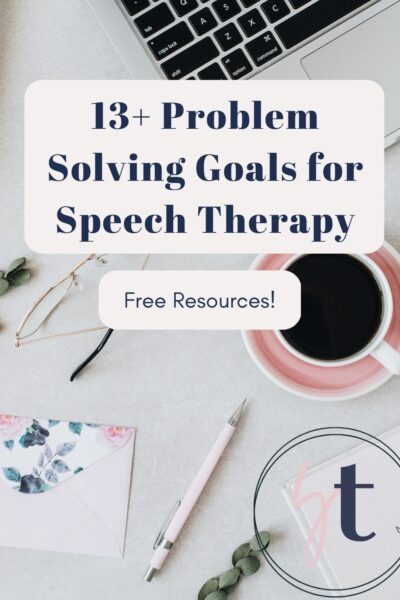
Short-Term Goals – Speech Therapy Goals
I know every district and even school setting has different ways it requires the goal writing of their objectives to be written, but typically my district wanted us to reduce either the number required or the percentage of achievement.
Here are a few examples to help get you started.
If we take a sample goal:
“Given a problem and problem solving graphic organizer, STUDENT will identify 3 solutions, the 3 consequences of those solutions, then determine the best solution, and explain why that is the best solution with 80% accuracy over 3 out of 4 consecutive sessions.”
- Reduced Number or Trials Required: The objective might be, “Given a problem and problem solving graphic organizer, STUDENT will identify 2 solutions, the 2 consequences of those solutions, then determine the best solution, and explain why that is the best solution with 80% accuracy over 3 out of 4 consecutive sessions.”
- Reduce Percentage of Accuracy: The objective might be, “Given a problem and problem solving graphic organizer, STUDENT will identify 3 solutions, the 3 consequences of those solutions, then determine the best solution, and explain why that is the best solution with 70% accuracy over 3 out of 4 consecutive sessions.”
- Reduce Difficulty of Task: The objective might be, “Given a problem and problem solving graphic organizer, STUDENT will pick from a selection of choices 2 possible solutions, the 2 possible consequences of those solutions, then determine the best solution, and explain why that is the best solution with 80% accuracy over 3 out of 4 consecutive sessions.”
- Reduce Number of Sessions of Accuracy: The objective might be, “Given a problem and problem solving graphic organizer, STUDENT will identify 3 solutions, the 3 consequences of those solutions, then determine the best solution, and explain why that is the best solution with 80% accuracy over 2 out of 4 consecutive sessions.”
(Meaning out of 4 therapy sessions in a row. They identified 3 possible solutions, the 3 consequences of those solutions and then determined the best solution in 2 out of 4 or 50% of the time in order to mark that goal mastered.)
As the speech pathologist, you are the specialist and you know your students’ communication disorders and child’s ability best though, so just take the functional goals from above and simplify them into achievable steps for your specific student.
SEE ALSO: 31 Best Wordless Videos to Teach Problem Solving
Data collections – problem solving goals speech therapy.
If you’re a speech therapist or have classroom teachers in need of data tracking forms while working on your student’s social interaction skills for speech therapy then be sure to check out my IEP goal data tracking for progress monitoring forms .
Or if you simply want a list of data sheets to choose from then be sure to check out my list of 35 free speech therapy data sheets roundup .

Visual Cue – Problem Solving Goals Speech Therapy
I always love using visual cues with my students. It can really help teach a concept that can be overwhelming.
Here is my problem solving graphic organizer that helps teach problem solving. As your child or student fills out the form you can start by providing helpful verbal prompts and hopefully, the more they work on their problem solving skills and will need less prompts.
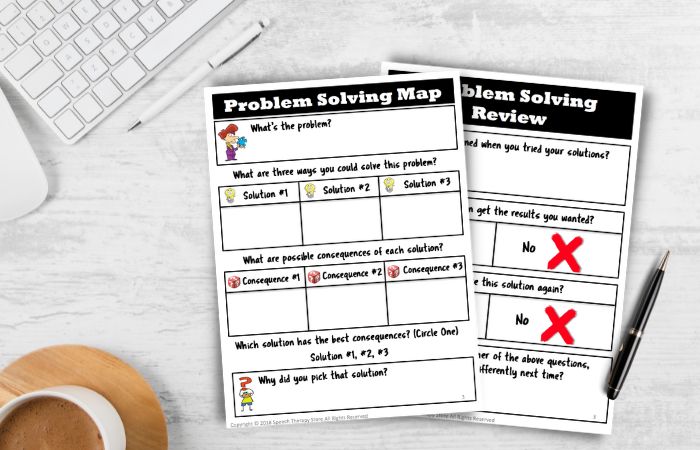
Here are all my blog posts about problem solving that you might also find helpful!
31 Best Wordless Videos to Teach Problem Solving – Watch the fun short youtube videos and then help solve the hypothetical problems.

71+ Free Social Problem-Solving Scenarios – Read the scenarios and practice solving the problems using the helpful graphic organizer pages.
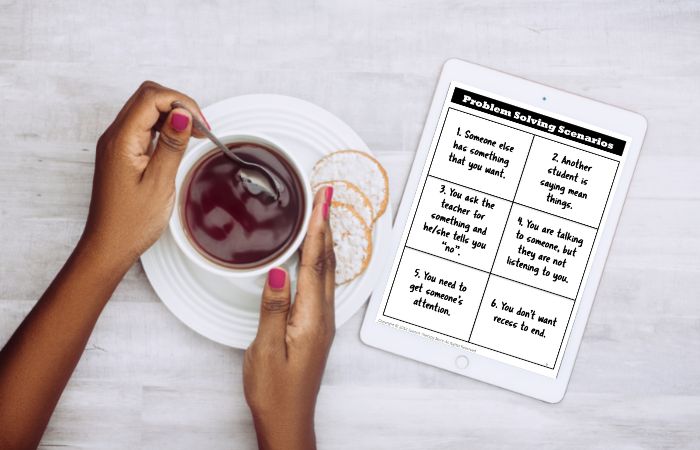
Problem Solving Wheel: Help Kids Solve Their Own Problems – Use our problem solving wheel or make your own individualized problem solving wheel for your specific student.
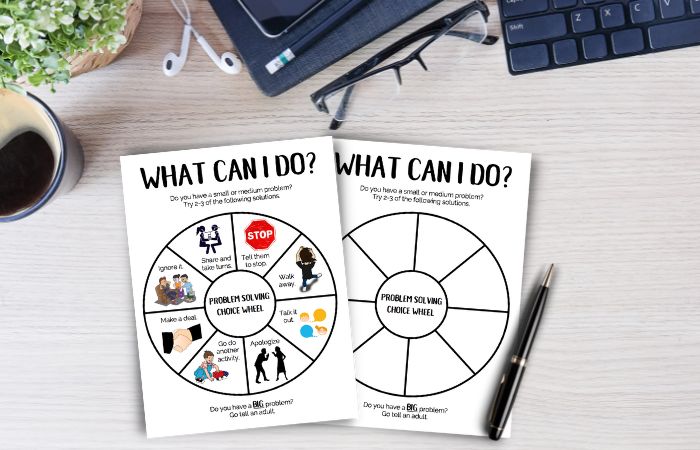
High School Students
The most important thing we can teach our high school aged students is how to advocate for themselves during their school day within a social setting.
Inside my tpt store I have a self-advocacy lesson to practice solving their school life problems in a functional way. Have your students grab a communication partner and get started!
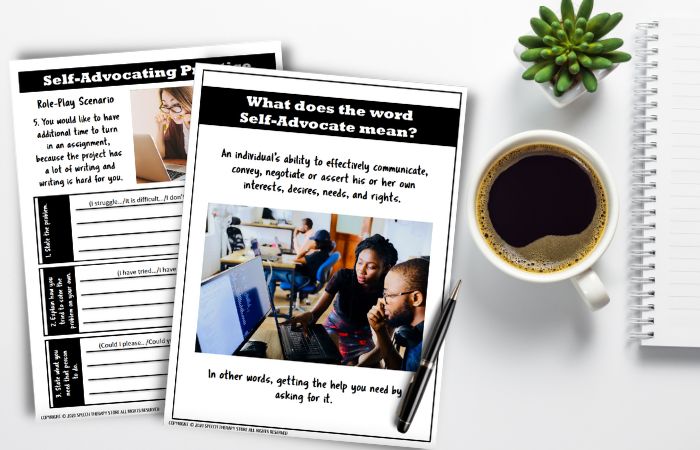
In addition to the self-advocacy lesson plan I also have a phone call lesson plan in my tpt store for making phone calls in the workplace or everyday life, such as calling the pharmacy or dentist’s office.
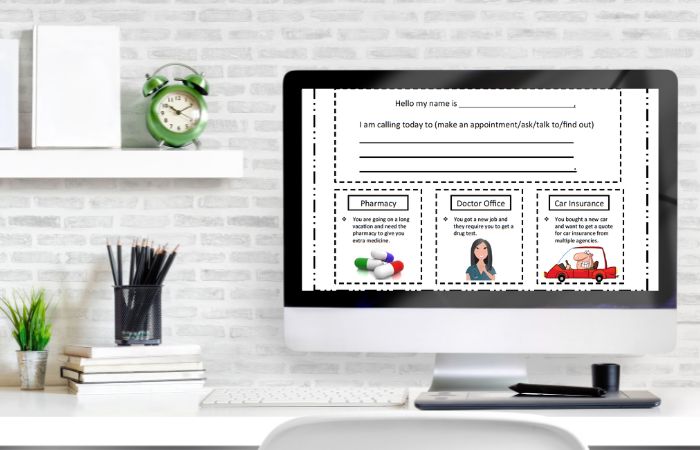
SEE ALSO: 71+ Free Social Problem-Solving Scenarios
Younger children.
Currently inside of my tpt store I have a problem size and reaction size lesson plan to help our younger children understand that problems are of different sizes and therefore different reaction sizes.
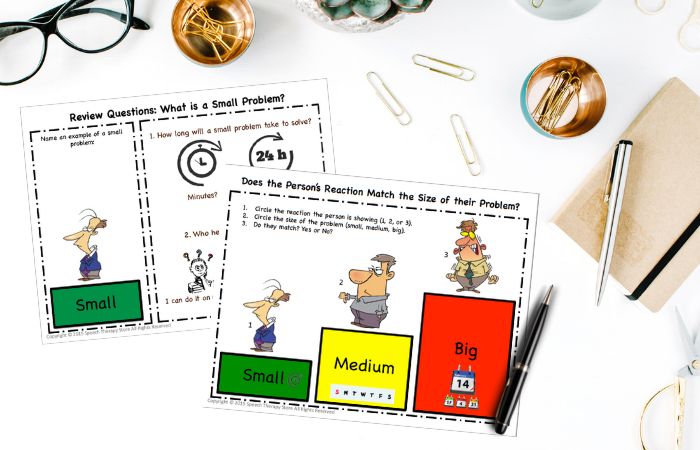
Another great problem solving resource in my tpt store is my problem solving restorative justice graphic visual to help children review their own feeling along with how the other person might have felt and then solve their problem.
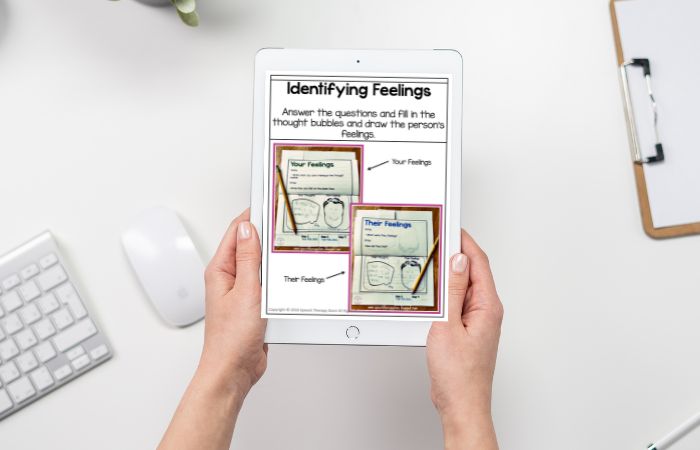
Picture Scene
- Social Scene Set 1 , Set 2 , Set 3 , Set 4 , Set 5 , & Set 6 by Contrary Chrissy – are different social scenes along with questions for problem solving.
- Back to School Social Language and Problem Solving Printable by Aimee Walton – includes different scenarios along with questions to help guide the student in solving the problem.
SEE ALSO: Problem Solving Wheel: Help Kids Solve Their Own Problems
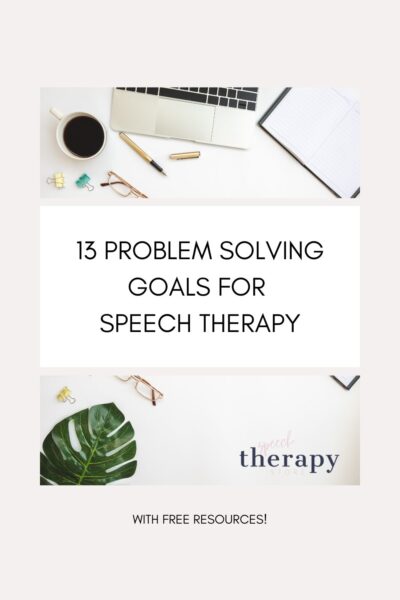
Social Conversation
If you’re looking for conversational skills to keep your middle school and high school aged students engaged, asking follow-up questions, or working on generalizing their skills across multiple settings you’ll want to check out the following blog posts.
These ideas are perfect for working in a small group setting on your student’s functional communication skills.
- Ideas to Help Keep Your Middle/High School Students Engaged – This post reviews 5 different strategies you can use to help keep your students engaged, such as using real life photos instead of little kid graphics and using materials at different levels allowing everyone to access the resources at their individual level.
- Ideas to Maintain a Conversation with Follow-Up Questions – Read how I help middle/high school students work on their social pragmatics of maintaining a conversation by using fun and interesting materials appropriate for their age.
- Ideas to Help Students Generalize Their Conversational Skills – Learn how I use self-rating forms to work on my student’s pragmatic language goals of generalizing their conversational skills across multiple settings and with multiple different people.
Short Story
- Inferencing and Problem-Solving FREEBIE by SLP to go – This resource is perfect for older students who are working on any of the following skills: inferencing, problem-solving, predicting, role-playing, or maintaining a conversation.
- Social Skills Problem Solving: Fighting with Friends by Let’s Build Language- Jaclyn Watson – Grab this freebie to help your students problem solve social challenges around fighting with friends.
In Conclusion: Problem Solving Goals Speech Therapy
I hope you found this list of problem solving goals to be helpful along with the resources.
Wishing you a wonderful year ahead!
Want Even More Problem Solving Goals Speech Therapy?
- 31 Best Wordless Videos to Teach Problem Solving
- 71+ Free Social Problem-Solving Scenarios
- Problem Solving Wheel: Help Kids Solve Their Own Problems
- 917+ Best Free Boom Cards for Speech Therapy
- 432+ Free Measurable IEP Goals and Objectives Bank
Want the Best of the Bests?
Be sure to check out our most popular posts below!
- 21 Best Reinforcement Games for Speech Therapy / Teletherapy
- Best IEP Resources
- 430+ Free Multisyllabic Words List Activity Bundle
- 279+ Free Speech Therapy Digital Materials
- 179+ Free Speech Therapy Wh-Questions Printable
- WV App Login
- Site Search
- Report Templates
- Speech Helpers
- SLP Resources
- Top 10 Tips
- Getting an Eval
- Certified SLP
- How to Say the R Sound
- 0-18 Months
- 18-36 Months
- 18-30 Months
- 30-36 Months
- 10-11 Years
- Articulation
- Cleft Palate
- Phonological
- Dysphagia Causes
- Dysphagia Treatment
30 Problem Solving Scenarios for Speech Therapy Practice
As promised here are the words for your unlimited use .
If you know others who can use our lists ...
... please share this page using our site share buttons.
Explore Our Goal Reaching, Client Centered Products

SEE ALSO: Houston We Have a Problem! Activities for Problem Solving
Problem solving scenarios.
- Your friends came over to your house for a movie night. One of your friends brought another friend so there are more people than you planned for. You want to pass out the drinks but you only have five cans of soda and you need 6 for everyone to have one. What could you do?
- After basketball practice you go back to the locker room with your team to shower and change. When you are done dressing, you can't find your shoes. What could you do?
- You have been waiting all day for lunch to come because you are starving. Finally class gets over and you get to go to lunch. Except when you go to get to your lunch, it's not there. You probably left it at home. What could you do?
- There is a guy in your class who is always mean to you. He always bumps you when he walks by and he calls you names. He knocks stuff out of your hands and makes you feel stupid. You don't think you can take it anymore. What could you do?
- You really want to invite this new girl/guy to come to your birthday party, but you have never talked to them before. You are worried they will say no. What could you do?
- You rode the bus to school today and on the way in people are pointing and laughing at you. You go in the bathroom and see that you have pink gum all over the back of your pants. What could you do?
- You wake up and see that your alarm never went off. So you are starting your morning 15 minutes later than you planned. It is a really important day at school and you cannot be late. What could you do?
- You are giving a group presentation in front of class and it's your turn to talk. All of the sudden you sneeze. You cover it with your hand, but now your hand is full of stuff you sneezed out. What could you do?
- You are eating dinner at a fancy restaurant with your parents and their friends. You have a really messy dinner and accidentally flip a noodle into the lady's lap. They are busy talking and don't notice it. What could you do?
- You are taking a test and there is no talking allowed. You are writing your answers on the paper and your pencil breaks. What could you do?
- You are taking a test and the guy behind you asks you for help. He wants to know what you put for question number two. What could you do?
- You are at a birthday party and you have waited in line for a long time for your turn to hit the pinata. It is finally going to be your turn and it looks like the next hit will break the pinata. But you suddenly have to go to the bathroom. What could you do?
- You are hanging outside with your friend and she decides to pick your neighbor's flowers. She gives you the pretty handful of flowers and right then your neighbor opens the door. She asks you why you picked her flowers. What could you do?
- You borrowed your sister's skates one day without asking and they broke while you were using them. What could you do?
- You are eating at a friend's house and the mom piles your plate full of food. It looks really good and you want to eat it all but you can't because you just ate a snack. What could you do so you don't hurt her feelings?
SEE ALSO: The Best Free App for Speech Therapy

- Your teacher was working at her desk. You wanted to ask her a question, but she didn't see your hand raised. What should you do?
- You started to do your work, but you weren't sure if you were doing it right. What should you do?
- You were playing tether-ball and were the champion so far. In the next game, you slightly touched the rope. Only one student saw you touch the rope. What will you do?
- The teacher is giving directions, but your friend sitting next to you keeps talking. You can't hear the directions. What should you do?
- You didn't do your homework. Your teacher was upset with you. What should you do?
- You finished eating and felt a burp coming. What are you going to do?
- You were waiting to swing. When it was your turn, another boy jumped in front of you and took the swing. What would you do?
- You waited a long time, but your mom didn't come to pick you up after school. What should you do?
- A bully threatened to beat you up after school. What should you do?
- A boy on the playground keeps pushing you and making you mad. What would you do?
- You were sitting in class doing your work and you hear the fire alarm. What should you do?
- An adult you didn't know came on to the playground and asked if you would help look for his lost dog. What would you do?
- You forgot your lunch at home. What would you do?
- The person sitting behind you keeps tapping your chair with his foot. What should you do?
- You finished your work early. What should you do?
This list of functional words was professionally selected to be the most useful for a child or adult who has difficulty with problem solving scenarios.
We encourage you to use this list when practicing at home.
Home practice will make progress toward meeting individual language goals much faster.
Speech-Language Pathologists (SLPs) are only able to see students/clients 30-60 mins (or less) per week. This is not enough time or practice for someone to handle Problem solving scenarios.
Every day that your loved one goes without practice it becomes more difficult to help them.
SEE ALSO: The Best Books for Speech Therapy Practice

We know life is busy , but if you're reading this you're probably someone who cares about helping their loved one as much as you can.
Practice 5-10 minutes whenever you can, but try to do it on a consistent basis (daily).
Please, please, please use this list to practice.
It will be a great benefit to you and your loved one's progress.
Freebies, Activities, and Specials, Oh My! Sign up for Terrific Therapy Activity Emails
See Past Email Examples
Your information is 100% private & never shared .

Hi! We're Luke and Hollie.
We are both MS CCC-SLPs and fell in love while studying for our degrees. Since then we have done everything together - graduated, worked, and started a family. We spend most of our time with our family and the rest making this site for you.

Top Free Resources

Word Vault Essential

# 1 Chronological Age Calculator

Popular Materials
All in one printable flashcards.

Multiple Meaning Word Mega Pack

Complete Articulation Word Search

New! 111 Articulation Stories

Teaching the Sound Books

Multi-Syllabic Words Flashcards

Apps to Save You Time & Help Your Clients
Articulation therapy + pirate adventures = awesomeness.

This App Will Get Your Kids Talking

Image Credits
Copyright © 2010 –
HomeSpeechHome.com | All Rights Reserved

This website contains affiliate links, meaning if you buy something from them we may make some money (at no cost to you). By using our affiliate links, you are helping to support our site which is a U.S.-based, family-run small business :)

21 Social Skills Activities for Speech Therapy
- allisonfors
- November 30, 2023
- No Comments
- Speech Resources , Therapy Ideas , Wh Questions

Social communication and pragmatic language is a critical skill in language development, cognitive growth, and communication skills.
Social communication includes social interaction, social cognition, pragmatics, and language processing. This includes body language, facial expressions, gestures, communicative intent, and topic maintenance. In short, it means knowing what to say, when to say it, and how to say it.
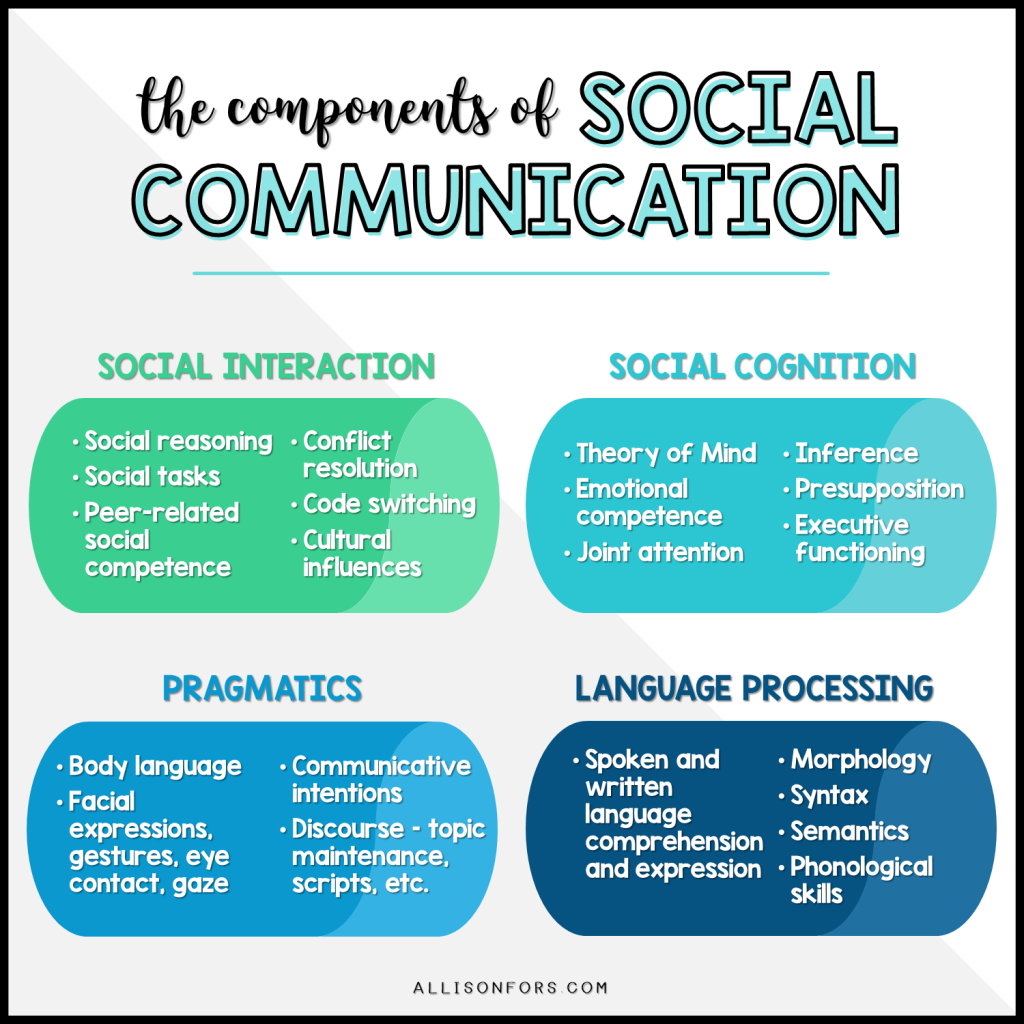
Here are social skills activities to download and use now! Scroll down to find teen social skills activities for older kids, as well as free social skills activities.

Social Skills Activities
SCHOOL-THEMED SOCIAL SCENARIOS – School-themed social skills for elementary kids. Work on a variety of pragmatics in social skills groups or one-on-one. These interactive activities will give your students control of the situations and questions presented. Includes 72 social situations, plus options to include custom-made ones depending on your student’s needs.
Prefer a digital, self-grading Boom Cards version of this product?

STORES SOCIAL SKILLS INTERACTIVE BOOK – Target community social skills, as well as categories, inferences, wh questions, pronouns, sentence formulation, following directions and more. Includes six stores and the book allows you to flip through the scenes and move the characters & objects onto the pages
CONVERSATION PROMPTS – 200 conversation prompts to use with your students! Great for social skills groups or individual sessions. Use in speech teletherapy! Target pragmatic language, articulation, fluency, answering questions, and sentence formulation.

BEHAVIOR MANAGEMENT – Use the scenes and cards to identify and discuss safe and respectful behaviors and how our choices affect others. Includes discussion questions, strategies, and a social story.
GOING TO THE DOCTOR AND DENTIST SOCIAL STORIES – Use these interactive books in speech therapy and more as social stories in preparation for going to the dentist and doctor, as well as discussing dental health and body health .
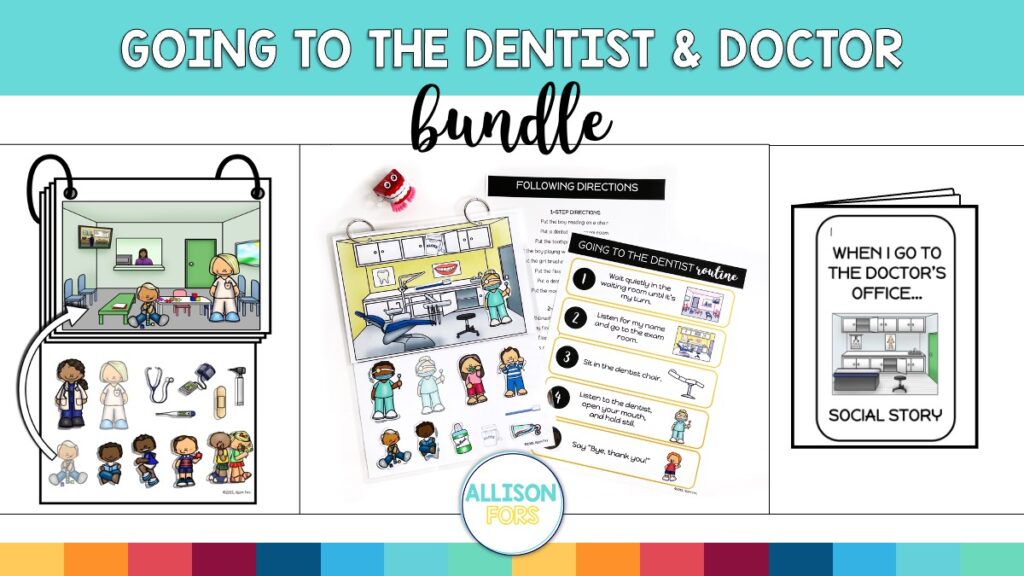
THOUGHT BUBBLE INFERENCES – Work on making inferences, problem solving, identifying emotions, feelings, empathy, what you should think versus say, and conversational skills. This activity can be open-ended or structured if used with the supports.
Social Emotional Activities
SOCIAL EMOTIONAL INTRODUCTION – Work on social emotional concepts with these printable, multilevel worksheets! Perfect for introducing feelings in repetitive, consistent activities that keep kids engaged. No prep, print and go pages (or just open on your device)! These pages are left open ended for flexibility for what emotion words you want to target and how difficult you want it to be.
EMOTIONS – Social emotional learning activities for kids. Help students identify and express their emotions, as well as others feelings.
EMOTIONS NO PRINT, INTERACTIVE PDF – Digital social emotional activities for identifying and expressing emotions and feelings with various expressive and receptive activities! Great for speech teletherapy!
Teen Social Skills Activities
TEEN COMMUNITY SOCIAL SCENARIOS – Social skills community activities for middle school and high school! Includes 80 social situations, plus options to include custom-made ones depending on your student’s needs.
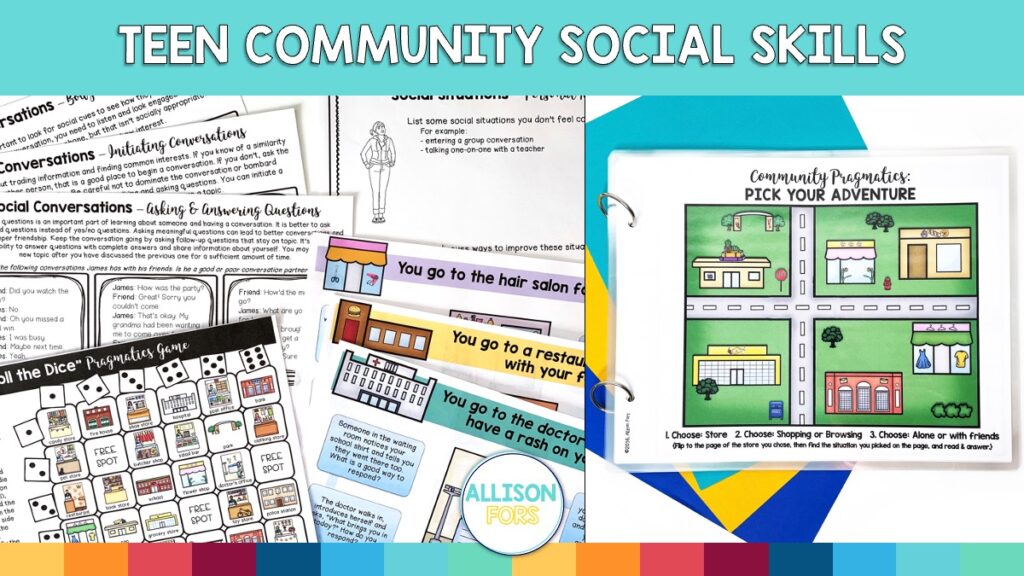
TEEN TRAVELING SOCIAL SCENARIOS – Use this thorough product designed to work on various social skills. These interactive activities will give your students control of the situations and questions presented. Includes 80 social situations, plus options to include custom-made ones depending on your student’s needs.
TEEN CONVERSATION PROMPTS – 100 conversation prompts to use with your students! Great for social skills groups or individual sessions. Use in speech teletherapy! Target pragmatic language, articulation, fluency, answering questions, and sentence formulation.
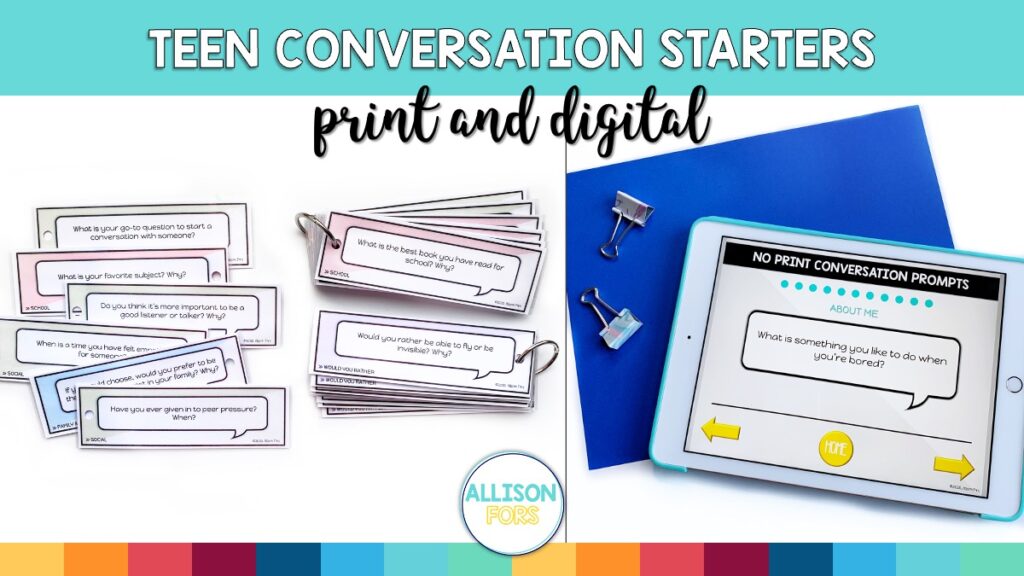
TEEN THOUGHT BUBBLE INFERENCES – Practice social skills: making inferences, identifying emotions, empathy, what you should think versus say, and conversational skills! This activity can be open-ended or structured if used with the supports. Pictures are appropriate for older students.
Social Skills Development
SPEECH-LANGUAGE DEVELOPMENT HANDOUTS –This is a “must-have SLP resource” including in-depth hierarchies and charts + parent-friendly explanations and their research. Use them in IEP meetings, as posters for your room, caregiver handouts, to write goals, and more! Stop worrying about memorizing milestones or frantically searching the internet for development charts.

AGE MILESTONES HANDOUTS – These reference pages provide an overview of speech and language milestones at different ages. Great for concise, easy-to-understand handouts to give to parents based on age!
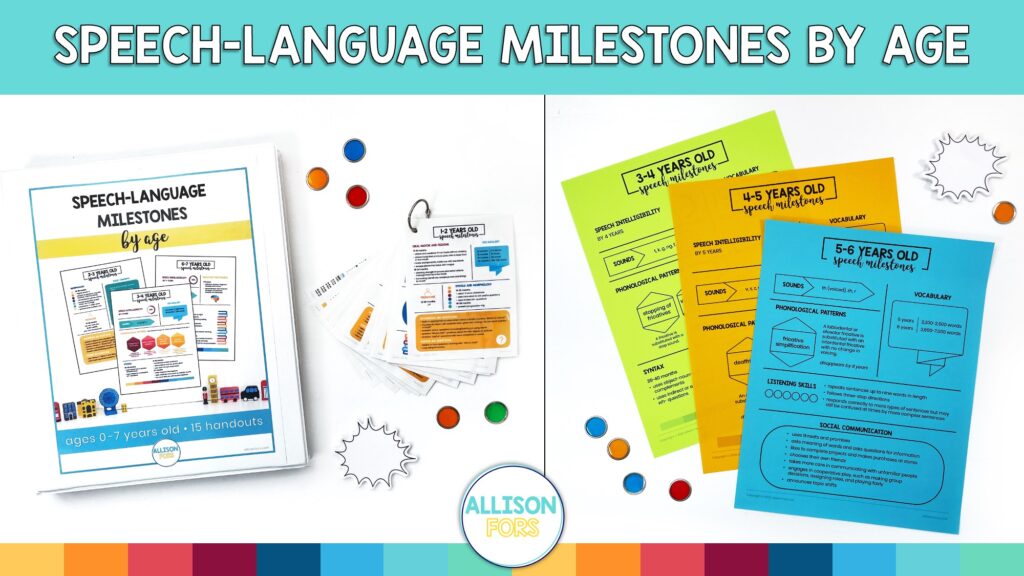
Free Social Skills Resources
FREE SOCIAL SKILLS RESOURCE LISTS – Discover ideas to plan and execute social skills therapy! Includes six pages of information and resources: types of social skills, developmental stages, websites, apps, and games.
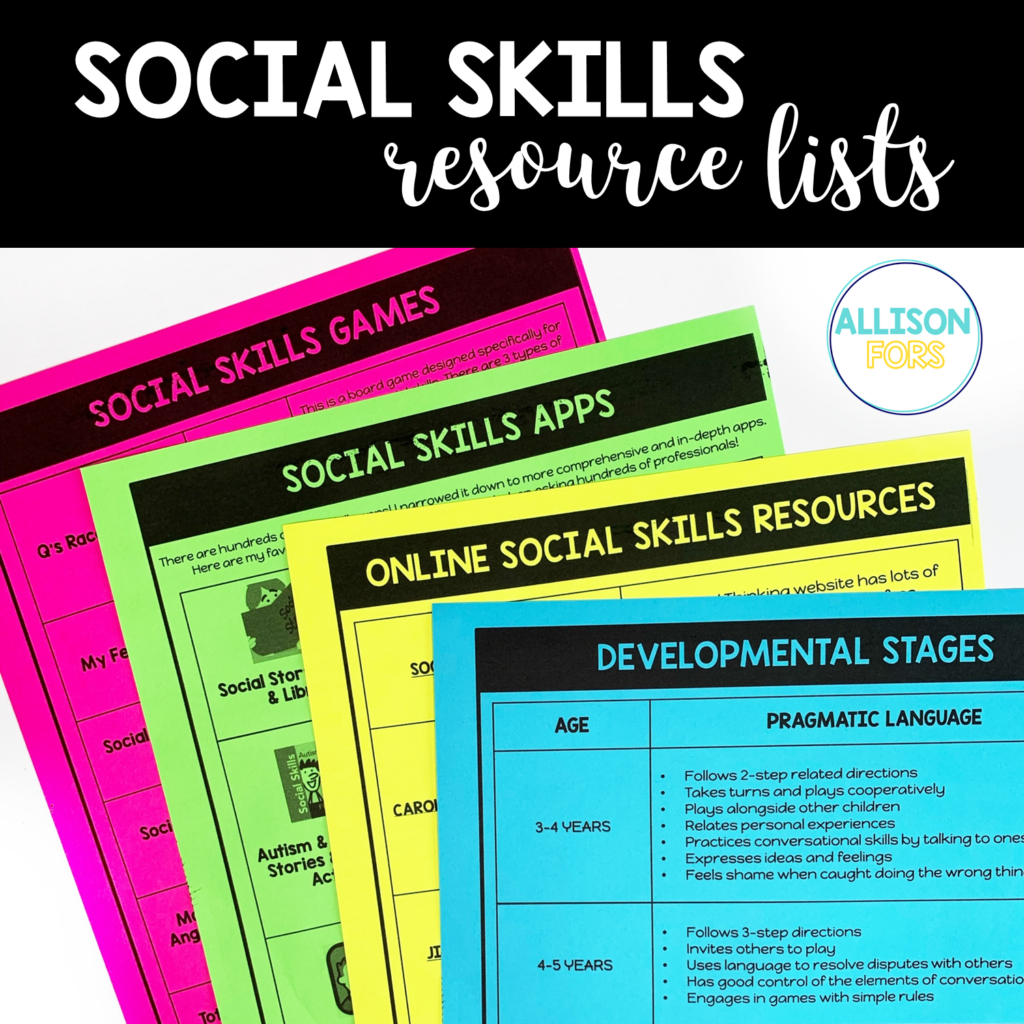
FREE “WHEN I’M FRUSTRATED” SOCIAL STORY – A social narrative mini-book on handling frustration with calming strategies. A great way to discuss feelings and appropriate ways to express them!

FREE CONVERSATION PROMPTS – Conversation prompts or ice breakers to use with your students in speech therapy or the classroom! Great for social skills groups or individual sessions. Target pragmatic language, articulation, fluency, answering questions, and sentence formulation.

What other social skills activities would you like to see added?
You may also be interested in reading:
Social Skills Ideas and Activities Social Skills You Should Be Targeting in Speech Therapy Games for Developing Social Skills The Difference Between Social Skills and Pragmatics

Leave a Reply Cancel reply
Your email address will not be published. Required fields are marked *
You Also Might Like...
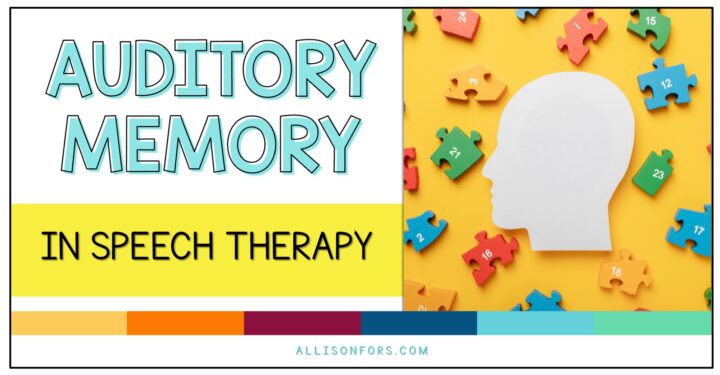
Auditory Memory and Processing in Speech Therapy

OT and PT Development Norms
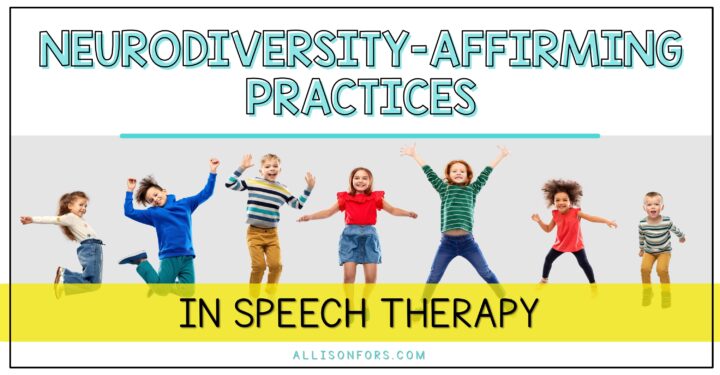
Making the Shift to Neurodiversity-Affirming Practice

The Difference Between a Delay and a Disorder

COPYRIGHT © 2024 · ALLISON FORS, INC.
TERMS & CONDITIONS
PRIVACY POLICY

Your cart is currently empty.
Total: $0.00

Free your time. Fresh, ready activities.
Speech therapy activities designed for therapists and kids to love.
Engaging Resources
Engaged therapy sessions, here you come! Speech & language activities that are guaranteed to catch the attention of any child. Perfect for digital learning and in-person fun.

BUNDLE Executive Function
✨ As seen on Boom Cards Featured Bundles!
This BUNDLE of executive function cards includes problem solving stories, social stories, predicting stories, sequencing stories, and flexible thinking stories.
Multiple types of wh- questions, why and how questions, labeling exercises, multiple choice, and drag and drop categorizations are included throughout this bundle to encourage an in depth understanding of each executive functioning skill.
⭐️ 80 Problem Solving
- Multiple choice question
- 2 labeling exercises
⭐️ 52 Social Stories
- Topics of social skills to choose from (feelings, manners, listening, sharing & turns, making friends, being kind)
- Sorting exercise
- 2 wh- questions
⭐️ 50 Predicting (✨ as seen on Top Premium Boom Cards ✨)
- What questions
- How questions
⭐️ 50 Sequencing
- 3 different what questions per story
⭐️ 40 Flexible Thinking (✨ as seen on Top Premium Boom Cards ✨)
- Why questions
- Labeling exercise
Each deck includes a teaching slide and visual to help your students better understand executive function skills before practicing!
CLICK HERE for Boom Cards Preview.
To use Boom Cards, you must be connected to the Internet. Boom Cards play on modern browsers (Chrome, Safari, Firefox, and Edge). Apps are available for modern Android, iPads, iPhones, and Kindle Fires. For security and privacy, adults must have a Boom Learning account to use and assign Boom Cards. You will be able to assign the Boom Cards you are buying with "Fast Pins," (a form of play that gives instant feedback to students for self-grading Boom Cards). For assignment options that report student progress back to you, you will need to purchase a premium account.If you are new to Boom Learning, you will be offered a free trial of our premium account.Read here for details: http://bit.ly/BoomTrial .

Wh- Questions & Short Stories
15 short stories to target wh- questions, auditory comprehension, reading comprehension, recall, and more!
Multiple levels of difficulty, including both shorter and longer paragraphs for a variety of length and detail in the stories.
⭐ Wh- Questions in Short Stories
- 15 Paragraph Short Stories
- 6 Wh- Questions for every story
- Stories are 4-9 sentences in length
- What, where, who, when, why, and how questions for every story
*This product contains the same activities as the Boom Cards version. If you would like the Boom Cards version, view Wh- Questions & Short Stories, Auditory Comprehension, Boom Cards.

Compare and Contrast
Compare and contrast a variety of topics with 5 different activities and over 400 prompts! Improve understanding and use of similarities and differences using this comprehensive activity.
This resource includes 5 different ways to practice comparing and contrasting , including stories, Venn diagrams, wh questions, short answers, pictures, graphs, and more. Real photos are included in this resource.
⭐️ Compare and Contrast:
- 5 stories with Venn diagrams
- 10 picture pairs with wh questions and Venn diagrams
- 10 picture pairs with wh questions and short answer questions
- 10 word pairs with wh questions and short answers
- 10 word pairs with graphs and word banks
- 2 blank templates
⭐️ Targeted Skills:
- Improve use of compare and contrast
- Increase comprehension of similarities and differences
- Expand skills for answering questions

Topics & Questions
80 unique topics with 4 wh- questions and a story prompt to improve expressive and receptive language skills, with REAL pictures. Questions and story prompts improve story telling and sentence generation skills. What, where, who, when, why, and how questions are included, with 4 different questions for each picture.
✨ As featured on Boom Cards Top Premium Decks ✨
⭐ 80 Topics & Categories
- 5 activities for each topic
- Real picture for every topic
- 4 wh-/how questions for every topic
- 1 story prompt for every topic
- What, where, who, when, why, and how questions included
⭐ Targeted Skills
- Improve receptive & expressive language
- Enhance skills for answering questions
- Boost story telling skills
- Develop noun labeling and describing
Practice describing topics and categories, by answering questions and discussing a story prompt for each topic!
To use Boom Cards, you must be connected to the Internet. Boom Cards play on modern browsers (Chrome, Safari, Firefox, and Edge). Apps are available for modern Android, iPads, iPhones, and Kindle Fires. For security and privacy, adults must have a Boom Learning account to use and assign Boom Cards. You will be able to assign the Boom Cards you are buying with "Fast Pins," (a form of play that gives instant feedback to students for self-grading Boom Cards). For assignment options that report student progress back to you, you will need to purchase a premium account. If you are new to Boom Learning, you will be offered a free trial of our premium account. Read here for details: http://bit.ly/BoomTrial .

Conversation Starters
Conversation starters to improve commenting, asking questions, and answering questions during conversations. Conversation prompts has variety of ways to practice conversations, including questions, open response, fill in the blank, and more.
This resource includes multiple ways to practice conversations , including pictures, comments, questions, asking questions, and more.
⭐️ All About Me Conversation Starters:
- 2 what questions
- 1 how question
- Open response opportunity
⭐️ Conversation Topics:
- 20 unique topics
- 3 open response opportunities to practice
- Practice asking questions and making comments
⭐️ Conversation Photos:
- 20 unique photo prompts
- 2 open response opportunities to practice
⭐️ Boom Cards include:
- 20 conversation topics
- 20 conversation starters with real photos
- Open response opportunities to practice
⭐️ Targeted skills:
- Improve conversation abilities
- Increase ability to ask and answer questions in conversations
- Expand commenting skills during conversations
NOTE: This resource includes 1 printable PDF with a Boom Cards companion. The Boom Cards contains part of the PDF resource, but does not include the "All About Me" conversation starters. Boom Cards are digital resources. PDF pages can be used digitally with PDF applications or can be printed for in person use.
To use boom cards, you must be connected to the internet. boom cards play on modern browsers (chrome, safari, firefox, and edge). apps are available for modern android, ipads, iphones, and kindle fires. for security and privacy, adults must have a boom learning account to use and assign boom cards. you will be able to assign the boom cards you are buying with "fast pins," (a form of play that gives instant feedback to students for self-grading boom cards). for assignment options that report student progress back to you, you will need to purchase a premium account. if you are new to boom learning, you will be offered a free trial of our premium account. read here for details: http://bit.ly/boomtrial ..

Problems & Solutions with Problem Size
Problem solving stories, problem size, solutions, common problems and more are included in this set. There are 80 unique problem solving and solution scenarios for critical thinking. Open response questions and multiple choice questions are included in every story! You will receive problem size and common problem teaching pages, as well as multiple examples.
⭐️ 80 Problem Solving Stories
- 80 unique problem scenarios
- Multiple choice question for every story
- 2 open response exercises for every story
⭐️ Problem Size Slides & Questions
- 5 in-depth teaching pages
- Problem size (small, medium, big) definitions
- Emotions related to problem sizes
- Color coordinated problem size visual
- 2 small problem exercises
- 2 medium problem exercises
- 2 big problem exercises
⭐️ Common Problems & Questions
- Teaching slide with definitions & examples
- 6 scenarios of common problems
- 2 free response problem & solution questions per scenario
With 80 unique stories, 12 common problem scenarios, 6 problem size questions and multiple teaching pages, you will be able to use this resource for many teaching sessions. You won't need anything else!

Story Builders & Create A Story
Improve creative writing with these narrative and short story prompts! This set of 70 short story builders comes with character, location, event and time learning targets.
Help your students improve their stories and increase their creative narrative skills. There is space for students to type or write their stories, as well as an organizing task for story parts.
Your students will have all the tools they need to create unique and imaginative stories!
⭐️ Includes:
- 70 story builders
- 3 practice levels
- A combination of who (character), where (location), what (event) and when (time) story part targets
- 36 story builders that include 2 story parts
- 20 story builders that include 3 story parts
- 14 story builders that include 4 story parts
- Story parts organizing task with pictures
- Space for creative writing and narrative generation
- Instructions on each page
⭐️ Teaching slides:
- In depth information about the 4 included story parts
- Descriptions
- Picture matching activities
Save your time and energy, this set is NO PREP! Includes everything you need to elicit creative, engaging stories from your students.
Perfect for SLPs, teachers, or parents looking to expand language or writing in a fun and creative way!

Social Skills & Pragmatics
Social skills and pragmatic language set to improve executive functioning skills. 52 unique stories with sorting and wh- questions!
Social skills topic can be organized by category or practiced in random order, depending on your goals! Your students will sort each card into "appropriate" or "inappropriate" categories. They also will have an opportunity to explain how to improve social skills. Keep students engaged with interactive drag and drop!
⭐️ 52 Social Skills short stories
- 2 scenarios per slide
- Drag and drop sorting for "appropriate" or "inappropriate" behavior
- What question to target improving behaviors
- Why question to target critical thinking
⭐️ Skills are able to be sorted by topic:
- Sharing & Turns
- Making Friends
BUNDLE for Executive Function Skills also available in Shine Speech Activities shop , which includes problem solving, predicting, flexible thinking, social skills, and sequencing/planning, too!
Use this deck to help teach and practice pragmatic skills - you won't need anything else!

Sentence Comprehension & Language Comprehension
Improve sentence comprehension, language and reading comprehension, and picture comprehension with 4 activities and over 125 prompts for speech therapy or classrooms! Target comprehending, receptive language, and more.
This resource includes 4 different ways to practice sentence comprehension , including wh questions, pictures, fill in the blanks, and more. Real photos are included in this resource.
⭐️ Sentence Comprehension:
- 40 sentence comprehension task cards with 3 questions each
- 30 real photo sentence comprehension prompts
- 30 multiple choice reading comprehension activities
- 30 fill in the blank language comprehension prompts
- Improve sentence comprehension skills
- Increase receptive and expressive language abilities
- Expand skills for understanding sentences and pictures

Categories with divergent naming, convergent naming, group, similarities, differences, and more! Words, cartoons, and real pictures included for a variety of ways to practice.
This resource includes 6 different ways to practice categories , including describing, naming, grouping, similarities, differences, and topics. Category cards include words, cartoon pictures to color, and real photos!
⭐️ Categories:
- 40 Describe the category
- 40 Name the category
- 40 Categories Grouping
- 24 Categories similarities
- 24 Categories differences
- 6 Categories Topics
- 10 Describe the category
- 15 Name the category
- 15 Categories Grouping
- 15 Categories similarities
- 15 Categories differences
- 5 Categories Topics
- Improve understanding categories
- Expand ability to describe categories
- Practice language with categories
NOTE: This resource includes 1 printable PDF with a Boom Cards companion. The Boom Cards contains part of the PDF resource. Boom Cards are digital resources. PDF pages can be used digitally with PDF applications or can be printed for in person use.

Picture & Word Describing Webs
This set of 70 picture description webs targets describing pictures and words by color, shape, size, location, material, function, category and more. Includes 8 wh- questions for each word!
Teaching slides are also included to teach your students how to describe pictures.
⭐️ Picture Description Webs:
- 8 fill in the blank questions to target descriptions
- Color description targets
- Size description targets
- Shape description targets
- Location description targets
- Material description targets
- Function description targets
- Category description targets
- Who (who uses it?) description targets
- Color coded targets to improve memory of ways to describe
⭐️ Teaching Slides:
- Question example for each description target
- Concrete examples of each description type
⭐️ Bonus Pages on PDF:
- Colored blank picture web template with 8 questions
- Black and white picture web template with 8 questions
BONUS! A blank PDF template for a color web and a black and white web are also included. Your students have the opportunity to draw their own unique pictures and create webs.
70 trials, plus blank webs, allows for unlimited practice of picture and word describing.
Help your students learn how to describe with this activity! PDF and Boom Cards versions are included.

Predicting in Short Stories
This activity includes 50 predicting stories . Unique and original scenarios for predicting practice!
✨ As seen on Boom Cards Top Premium Decks ✨
Each scenario includes a "what" question and a "how" question for further discussion and analysis for your students.
50 stories means you won't need any other activity for predicting! Use these randomized trials track data over multiple sessions.
⭐️ 50 Predicting story slides
- Unique predicting scenarios
- What question for predicting
- How question for analyzing prediction

BUNDLE Figurative Language
This BUNDLE of figurative language cards includes idioms, metaphors, hyperboles, personification and similes. Over 255 practice targets with figurative language!
The set targets multiple skills so your students will have an in depth understanding of each type of figurative language! This set is a truly comprehensive approach to understanding and using figurative language.
⭐️ 60 Idioms
- Yes/no questions for every trial
- What questions for every trial
- Free response (students have an opportunity to create their own idioms) for every trial
⭐️ 40 Metaphors
- Free response (students have an opportunity to create their own metaphors) for every trial
⭐️ 40 Similes
- Free response (students have an opportunity to create their own similes) for every trial
⭐️ 45 Hyperboles
- Free response (students have an opportunity to create their own hyperboles) for every trial
⭐️ 40 Personification
- Free response to give students opportunity to create short stories with personification
⭐️ 35 Allusions
- 2 what questions for every trial
- Free response to encourage building allusions in sentences
- Allusions to Historical figures, literature, famous fictional characters, locations/landmarks, Greek mythology, movies and more
⭐️ Each deck includes a teaching slide
- Definitions
- Help your students understand and identify figurative language before practicing
Preview Boom Cards HERE.

Prepositions & Spatial Concepts
This set of prepositions targets spatial and location concepts with 60 trials ! Teach your students prepositions and location with this robust, comprehensive deck.
You can pick which preposition to target, or practice with randomized slides. The teaching module will teach your students everything they need to know about each preposition before practicing!
⭐️ Prepositions include:
⭐️ learning module includes:.
Use the practice slides to practice prepositions with multiple choice. Navigate between the learning module and practice cards using the buttons at the bottom of each slide.
CLICK HERE for Boom Card Preview.
To use Boom Cards, you must be connected to the Internet. Boom Cards play on modern browsers (Chrome, Safari, Firefox, and Edge). Apps are available for modern Android, iPads, iPhones, and Kindle Fires. For security and privacy, adults must have a Boom Learning account to use and assign Boom Cards. You will be able to assign the Boom Cards you are buying with "Fast Pins," (a form of play that gives instant feedback to students for self-grading Boom Cards). For assignment options that report student progress back to you, you will need to purchase a premium account. If you are new to Boom Learning, you will be offered a free trial of our premium account. Read here for details: http://bit.ly/BoomTrial .

Main Idea & Supporting Details
Main idea and supporting details with 5 different ways to practice and 50 unique prompts! Improve reading comprehension and writing skills using this main ideas and detail resource.
This product contains a PDF version and a Boom Cards companion.
This resource includes 5 different ways to practice main idea and supporting details , including stories with questions, main ideas vs. details, create-a-story, grouping, and pictures with questions. Real photos are also included in this resource.
⭐️ Main Idea & Details:
- 10 Stories & Questions
- 10 Main Ideas vs. Details
- 10 Create-A-Story
- 10 Grouping
- 10 Pictures & Questions
- Improve understanding main ideas and details
- Increase reading comprehension abilities
- Expand skills for creating stories
To use Boom Cards, you must be connected to the Internet. Boom Cards play on modern browsers (Chrome, Safari, Firefox, and Edge). Apps are available for modern Android, iPads, iPhones, and Kindle Fires. For security and privacy, adults must have a Boom Learning account to use and assign Boom Cards. You will be able to assign the Boom Cards you are buying with "Fast Pins," (a form of play that gives instant feedback to students for self-grading Boom Cards). For assignment options that report student progress back to you, you will need to purchase a premium account. If you are new to Boom Learning, you will be offered a free trial of our premium account. Read here for details: http://bit.ly/BoomTrial .

Expanding Language with Wh Questions and Real Pictures
Expand expressive language using wh- questions and sentence generation prompts with real pictures. Improve expressive language, answering questions, labeling verbs, and story generation! What, where, and who questions are included for every picture!
⭐ Expanding Language with Real Pictures
- 80 real life pictures
- 3 wh- questions for every story
- Free response prompt for every story
- Large variety of actions and topics within pictures
- What, where, and who questions for every story
- Printable pages
⭐ Targeted Skills
- Improve expressive language
- Enhance skills for answering questions
- Boost sentence and story generation skills
- Develop verb describing and labeling

Sequencing and Planning
This set of 50 sequencing and planning activity deck will help your students improve their planning skills! The deck includes a variety of sequencing and planning scenarios and trials for your students.
Each open-ended short story includes 3 color-coded wh- questions to guide sequencing.
⭐️ 50 Sequencing short stories
- Unique sequencing stories
- 3 wh- questions per story
- Color-coded questions, to match teaching slide
⭐️ Teaching slide
- 6 unique teaching slides with visuals
- Color-coded information to match questions in trials
- Drag & drop activity
- Synonyms for key words
- Example of a story sequence
CLICK HERE for Boom Cards Preview

Flexible Thinking & Reframing
This set of 40 flexible thinking and reframing thoughts cards teaches your students how to improve flexible thinking in difficult situations.
Each unique scenario includes multiple questions as well as a labeling exercise to encourage flexible thinking and increasing creative problem solving.
⭐️ Each Flexible Thinking trial includes:
- Why question
- How question
⭐️ Teaching slides include:
- Flexible v. rigid thinking comparison
- Flexible thinking examples
- Strategies for use of flexible thinking in difficult moments
INCLUDES: Both a PDF version and a Boom Cards version!

BUNDLE for Wh- Questions also available in Shine Speech Activities shop , which includes short stories and sentences!
CLICK HERE for Boom Cards Preview .
*This product contains the same activities as the PDF version. If you would like the PDF version, view Wh- Questions & Short Stories, Auditory Comprehension .

Inferencing & Context Clues
70 inferencing and context clues trials to improve critical thinking skills! Each trial comes with 4 unique clues to help your students make an inference. They can then provide their answer, and drag the cover away to see the correct answer and a picture.
⭐️ As featured on Boom Cards Top Premium Decks ⭐️
⭐ 70 Inferencing & Context Clues Slides:
- 4 clues for every word
- Space to type an answer
- Drag to uncover the correct answer
- Pictures of the correct answer
⭐ Skills targeted:
- Improve inferencing
- Enhance ability to understand clues
- Increase critical thinking and executive function abilities
- Boost deductive reasoning skills
- Improve ability to draw conclusions
Shop Best Sellers
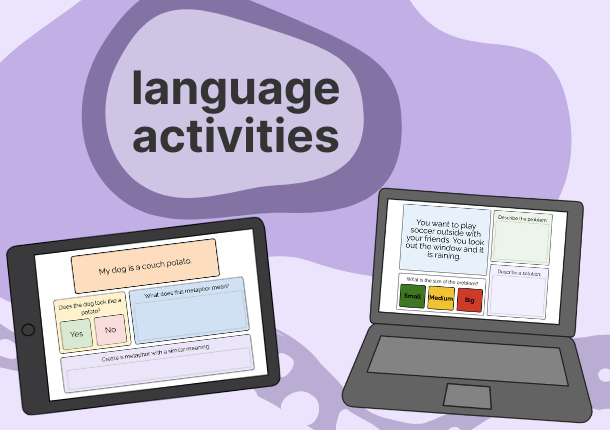
Thoughtfully designed, for you.

Aliceann R.
Free Resources
From our speech room to yours.
Get the latest & greatest activities right in your inbox.
Made with love in Austin, Texas
© 2020 Shine Speech Activities
Product Added To Your Cart
There are 0 Items In Your Cart
Total Price: $0.00
Compare Product
Join Pilot Waitlist

Home » Blog » General » Exploring Perspective Taking Activities for Speech Therapy: Promoting Empathy and Communication

Exploring Perspective Taking Activities for Speech Therapy: Promoting Empathy and Communication
As a Speech Language Pathologist, I understand the importance of perspective taking in speech therapy. Perspective taking is a crucial skill that promotes empathy and communication, allowing individuals to understand and consider the thoughts, feelings, and experiences of others. In this blog post, I will explore various perspective taking activities that can be incorporated into speech therapy sessions to enhance social emotional learning and foster meaningful connections. Let’s dive in!
Understanding Perspective Taking
Perspective taking can be defined as the ability to understand and consider the viewpoints of others. It involves stepping into someone else’s shoes, seeing the world from their perspective, and understanding their thoughts, feelings, and motivations. In the context of social emotional learning, perspective taking plays a vital role in developing empathy, communication skills, and building positive relationships.
When individuals are able to take on different perspectives, they become more empathetic and understanding towards others. This skill allows them to navigate social interactions effectively, resolve conflicts, and communicate their own thoughts and feelings in a respectful manner. In speech therapy, perspective taking is particularly important as it helps individuals improve their communication skills, understand nonverbal cues, and develop a deeper understanding of social norms and expectations.
Perspective Taking Activities for Speech Therapy
Now that we understand the significance of perspective taking, let’s explore some engaging activities that can be incorporated into speech therapy sessions to promote this skill:
Activity 1: Role-playing scenarios
Role-playing scenarios provide individuals with the opportunity to step into different roles and experience situations from various perspectives. This activity can be done in pairs or small groups, where each person takes on a different role and acts out a specific scenario. For example, individuals can role-play a conflict between two friends and then switch roles to understand the perspectives of both parties.
Role-playing scenarios promote perspective taking by allowing individuals to see things from different angles. It encourages them to consider the thoughts, feelings, and motivations of others, fostering empathy and understanding. To implement this activity effectively, provide clear instructions, encourage active participation, and facilitate discussions after each role-play to reflect on the experience.
Activity 2: Using visual aids
Visual aids are powerful tools that can enhance perspective taking in speech therapy. They can include photographs, drawings, or videos that depict different situations, emotions, or perspectives. For example, you can show a picture of a crowded classroom and ask individuals to describe how they think a student with social anxiety might feel in that situation.
Using visual aids promotes perspective taking by providing individuals with visual cues that help them understand and empathize with different perspectives. It allows them to analyze facial expressions, body language, and other nonverbal cues, enhancing their ability to interpret and respond to social situations. When creating and using visual aids, ensure they are age-appropriate, relevant, and engaging for the individuals you are working with.
Activity 3: Storytelling and narrative therapy
Storytelling and narrative therapy are powerful tools for promoting perspective taking in speech therapy. Encourage individuals to share personal stories or engage in storytelling activities where they create fictional narratives. After each story, discuss the perspectives of the characters and how they might have felt or thought in different situations.
Storytelling promotes perspective taking by allowing individuals to explore different viewpoints and understand the complexity of human experiences. It encourages them to consider the thoughts, feelings, and motivations of others, fostering empathy and compassion. Incorporate storytelling into therapy sessions by providing prompts, asking open-ended questions, and encouraging individuals to express their own perspectives as well.
Activity 4: Collaborative problem-solving
Collaborative problem-solving activities provide individuals with the opportunity to work together to find solutions to real-life problems. This can be done through group discussions, brainstorming sessions, or problem-solving games. Encourage individuals to consider different perspectives, listen actively to others’ ideas, and work towards a mutually beneficial solution.
Collaborative problem-solving promotes perspective taking by encouraging individuals to consider multiple viewpoints and find common ground. It fosters effective communication, critical thinking, and empathy. To facilitate collaborative problem-solving, create a safe and supportive environment, establish clear guidelines for respectful communication, and provide guidance when conflicts arise.
Strategies for Enhancing Perspective Taking Skills
In addition to incorporating perspective taking activities into speech therapy sessions, there are strategies that can be implemented to enhance perspective taking skills in everyday life:
Encouraging active listening
Active listening involves fully engaging with others, paying attention to their words, body language, and emotions. Encourage individuals to practice active listening by maintaining eye contact, asking clarifying questions, and summarizing what they have heard. This helps them understand different perspectives and fosters effective communication.
Practicing perspective taking in everyday situations
Encourage individuals to practice perspective taking in their daily lives. This can be done by asking them to consider how others might feel or think in different situations, encouraging empathy and understanding. Prompt them to reflect on their own thoughts and feelings as well, promoting self-awareness and self-reflection.
Using literature and media to explore different perspectives
Literature and media provide rich opportunities to explore different perspectives. Encourage individuals to read books, watch movies, or engage with other forms of media that depict diverse characters and experiences. Discuss the perspectives of the characters and how they relate to real-life situations, fostering empathy and critical thinking.
Perspective taking is a crucial skill that promotes empathy and communication in speech therapy. By incorporating perspective taking activities into therapy sessions and implementing strategies for enhancing perspective taking skills in everyday life, individuals can develop a deeper understanding of others, improve their communication skills, and build meaningful connections. Start your EverydaySpeech Free trial today and discover a wide range of resources and activities to support perspective taking and social emotional learning in speech therapy.

Related Blog Posts:
Pragmatic language: enhancing social skills for meaningful interactions.
Pragmatic Language: Enhancing Social Skills for Meaningful Interactions Pragmatic Language: Enhancing Social Skills for Meaningful Interactions Introduction: Social skills play a crucial role in our daily interactions. They enable us to navigate social situations,...
Preparing for Success: Enhancing Social Communication in Grade 12
Preparing for Success: Enhancing Social Communication in Grade 12 Key Takeaways Strong social communication skills are crucial for academic success and building meaningful relationships in Grade 12. Social communication includes verbal and non-verbal communication,...
Preparing for Success: Enhancing Social Communication in Grade 12 Preparing for Success: Enhancing Social Communication in Grade 12 As students enter Grade 12, they are on the cusp of adulthood and preparing for the next chapter of their lives. While academic success...

FREE MATERIALS
Better doesn’t have to be harder, social skills lessons students actually enjoy.
Be the best educator you can be with no extra prep time needed. Sign up to get access to free samples from the best Social Skills and Social-Emotional educational platform.
Get Started Instantly for Free
Complete guided therapy.
The subscription associated with this email has been cancelled and is no longer active. To reactivate your subscription, please log in.
If you would like to make changes to your account, please log in using the button below and navigate to the settings page. If you’ve forgotten your password, you can reset it using the button below.
Unfortunately it looks like we’re not able to create your subscription at this time. Please contact support to have the issue resolved. We apologize for the inconvenience. Error: Web signup - customer email already exists
Welcome back! The subscription associated with this email was previously cancelled, but don’t fret! We make it easy to reactivate your subscription and pick up right where you left off. Note that subscription reactivations aren't eligible for free trials, but your purchase is protected by a 30 day money back guarantee. Let us know anytime within 30 days if you aren’t satisfied and we'll send you a full refund, no questions asked. Please press ‘Continue’ to enter your payment details and reactivate your subscription
Notice About Our SEL Curriculum
Our SEL Curriculum is currently in a soft product launch stage and is only available by Site License. A Site License is currently defined as a school-building minimum or a minimum cost of $3,000 for the first year of use. Individual SEL Curriculum licenses are not currently available based on the current version of this product.
By clicking continue below, you understand that access to our SEL curriculum is currently limited to the terms above.

Problem Solving Activities for Adults Speech Therapy
Problem-solving activities for adults speech therapy are a way to help adults who have had one or more strokes to recover and regain their ability to communicate. Many people who have had strokes can’t speak at all after the stroke, or they lose their ability to understand what other people say. After having a stroke, some people find that their problem-solving skills also suffer. These skills can be regained and improved through speech therapy.

Problem-solving skills are not just useful in the workplace—they’re also necessary for managing everyday life. But when a person has suffered from a stroke, brain injury, or other kind of trauma that affects their ability to communicate and understand, problem solving can become difficult. Speech therapy is a great way to help people with these issues get back on their feet.
In order to solve problems, you need to be able to think critically about them and come up with ways to deal with them. Problem solving is the art of looking at a problem from different angles until you find one that works. It’s not always easy! Sometimes we have trouble seeing past our own biases or assumptions about what should be done in any given situation, but it’s important that we give ourselves time to work through these issues before jumping into action.
Speech therapy is a service that speech-language pathologists provide to help people who have voice, speech, language and swallowing disorders. Speech therapy is provided by trained professionals called speech-language pathologists or SLPs. SLPs are highly educated health professionals with undergraduate degrees in communication sciences and disorders (CSD) or communicative disorders, along with intensive clinical training.

Problem-solving activities for adults with aphasia are specifically designed to help people with aphasia improve their language skills. Aphasia is a communication disorder that causes difficulty with speaking, reading, writing, and listening.
Problem solving activities are designed to help adults who have suffered a stroke, brain injury, or other disability to improve their speech and cognitive skills. Stroke recovery therapy is often focused on rehabilitating the areas of the brain responsible for language, which can be achieved through problem solving activities. Because problem solving activities engage different parts of the brain, they strengthen neural networks, improving a person’s ability to communicate.
Problem solving activities have been shown to improve cognitive skills like memory and focus, while also improving physical function and mood. For many patients, the benefits of this type of therapy are long-lasting. By engaging the parts of the brain that control speech and language, problem solving activities can help people with disabilities return to normal life after a stroke or traumatic brain injury.
Problem-solving activities are a great way for adults to work through issues on their own, or with others. The basis of a good problem-solving activity is that it requires the participants to use their problem-solving skills to complete the task. This can be done in a number of ways.
Problem solving activities for adults speech therapy are meant to help clients apply their newfound knowledge in the real world. This process typically starts with the therapist helping the client identify problems that need to be addressed in their lives and then working through various means to solve them. For example, a client who suffers from stuttering might have difficulty getting his point across at work. The therapist might use role play in order to help him figure out new ways to communicate what he needs to say (e.g., writing it down), or she might teach him how to be more assertive when speaking up for himself.
Problem-solving activities are some of the most fun, engaging, and satisfying activities for adults in speech therapy. Instead of performing repetitive drills, you will work on real-life tasks that help you overcome barriers to communication. Because these activities are so varied and can be adapted to meet your individual needs, they are highly effective for both children and adults.
In order to carry out problem-solving activities, adults should have a thorough understanding of the problem. They need to determine what the problem is, and identify the possible solutions for it. Adults should then decide on the best solution to the problem, and evaluate the effectiveness of this solution. Problem-solving activities benefit adults in speech therapy by helping them improve their communication skills, in addition to improving their fine motor skills and memory. Problem-solving activities also help adults in speech therapy improve their cognitive, social and language skills.
Leave a Comment Cancel Reply
Your email address will not be published. Required fields are marked *
Save my name, email, and website in this browser for the next time I comment.

COMMENTS
7. Browse The Web. Review how to open web browsers, use search engines like Google, check email, and close tabs. Even these seemingly simple tasks can be life-changing for motivated patients. 8. Update a Calendar. An ongoing practical cognitive task for patients is updating their calendars.
Kathryn J. Tomlin, M.S., CCC-SLP, has been a speech-language clinician in hospitals, rehabilitation centers, and in long-term care facilities for over 25 years. She has authored many materials with LinguiSystems over the last 20 years. Some of her works include: WALC 1(Workbook of Activities for Language and Cognition)- Aphasia Rehab
Calculate the costs of lodging and food. 9. Math in Everyday Life: Shopping Spree! We originally called this activity "Weekly Ads"….but that didn't sound as fun as a shopping spree! Come up with cognitive speech therapy activities for adults around planning and creating a shopping list.
#4 Problem Solving. Make a smart guess about how a character will solve a problem. How will they fix that? This skill leads fantastically into size of the problem activities and solving problems in the real world! Photographs are perfect to work on social inferences in speech therapy. #5 Causal
Use the 71 social problem-solving scenarios to have your students get great experience practicing how to solve a social problem. Also, included are 6 blank scenarios. Then laminate them so you can use them over and over again. Therefore, create social problems that the student experiences and needs help solving.
Some of the commonly practised problem solving activities within adult speech therapy are: Tongue Exercises: The first step in re-training oneself to practise correct speech patterns should be to gain better control over the tongue. Moving and exercising is an essential part of speech therapy. Tongue training exercises can help the mouth to ...
Involving Parents in Problem-Solving Activities. Speech therapists can involve parents in problem-solving activities by providing them with information and strategies to support their child's development. This collaboration ensures that problem-solving skills are reinforced both in therapy sessions and at home.
These 100 problem-solving scenarios present real-life problems that clients must navigate at school and home. Have the client discuss what they would do if…. 1. You are visiting relatives that you don't know very well. Your parents ask you to sit down and talk to them. 2. Your family sits down for a special meal.
B. Role of speech therapy in enhancing problem-solving abilities. Speech therapy is an invaluable resource for individuals who struggle with communication and language skills. ... Consistent practice is key to developing problem-solving skills. Speech therapists can encourage parents and caregivers to incorporate problem-solving activities into ...
Here are some of my tips for teaching problem solving skills to students in speech therapy. Tip #1 for Teaching Problem Solving. Understand the process. Successful problem solving is a process that begins with identifying that there is a problem, thinking through possible solutions, and then selecting and implementing the best solution to that ...
Problem solving activities are an essential component of speech therapy for adults. These activities help individuals develop and improve their communication skills by challenging their cognitive abilities. By engaging in problem solving tasks, adults can enhance their problem-solving skills, critical thinking, and decision-making abilities.
Comprehension. Memory. Problem-solving skills. After a brain injury, many of these cognitive skills can become impaired. Fortunately, cognitive speech therapy, also referred to as cognitive-communication therapy, is designed to help improve communication skills and restore cognitive function. When the areas of the brain responsible for speech ...
This blog presents eight simple and effective activities requiring minimal preparation and maximizing fun while promoting speech and language development. 1. Storytelling and Sequencing. Storytelling is a wonderful way to boost language skills and improve narrative abilities. Prepare picture cards or gather props to create visual aids.
Speech therapists can incorporate problem-solving activities into their sessions to provide individuals with opportunities to practice their skills in a structured setting. These activities can range from solving puzzles and riddles to engaging in role-playing scenarios that require creative thinking and decision-making.
Speech therapy activities can focus on teaching problem-solving strategies and promoting conflict resolution skills. To develop problem-solving and conflict resolution skills: Break down problem-solving into steps, such as identifying the problem, brainstorming solutions, evaluating options, and implementing a plan. Use real-life scenarios to ...
6. Given a real-life or role-play conflict scenario, STUDENT will remain calm and relaxed, listen to the other person, and determine what they can agree on with 80% accuracy in 4 out of 5 opportunities. 7. Given criticism or feedback, STUDENT will look at the person, say "okay", and not argue with 80% accuracy in 4 out of 5 opportunities. 8.
Home practice will make progress toward meeting individual language goals much faster. Speech-Language Pathologists (SLPs) are only able to see students/clients 30-60 mins (or less) per week. This is not enough time or practice for someone to handle Problem solving scenarios. Every day that your loved one goes without practice it becomes more ...
Create social stories that focus on common social challenges, such as sharing, taking turns, or making friends. Use visuals and simple language to make the stories engaging and relatable. 3. Board Games: Board games offer a fun and interactive way to target social skills. Choose games that require turn-taking, cooperation, and problem-solving.
THOUGHT BUBBLE INFERENCES - Work on making inferences, problem solving, identifying emotions, feelings, empathy, what you should think versus say, and conversational skills. This activity can be open-ended or structured if used with the supports. Social Emotional Activities. SOCIAL EMOTIONAL INTRODUCTION - Work on social emotional concepts with these printable, multilevel worksheets!
Speech therapy materials and activities for speech and language disorders. Free and fun SLP therapy materials. Read-to-use, digital and printable, no prep speech activities. ... This BUNDLE of executive function cards includes problem solving stories, social stories, predicting stories, sequencing stories, and flexible thinking stories ...
Incorporate storytelling into therapy sessions by providing prompts, asking open-ended questions, and encouraging individuals to express their own perspectives as well. Activity 4: Collaborative problem-solving. Collaborative problem-solving activities provide individuals with the opportunity to work together to find solutions to real-life ...
Problem solving activities have been shown to improve cognitive skills like memory and focus, while also improving physical function and mood. For many patients, the benefits of this type of therapy are long-lasting. By engaging the parts of the brain that control speech and language, problem solving activities can help people with disabilities ...